


















As our 125th-anniversary year draws to a close, I am filled with a profound sense of pride and gratitude—pride in the remarkable history and accomplishments of our beloved institution and gratitude for the opportunity to lead Waynflete as we navigate the challenges and opportunities of the present and future.
Our story began in 1898, when two extraordinary women, Caroline Crisfield and Agnes Lowell, founded The Portland School for Girls. These visionary educators were driven by a powerful mission: to prepare young women for college and to cultivate in them a deep sense of social responsibility.
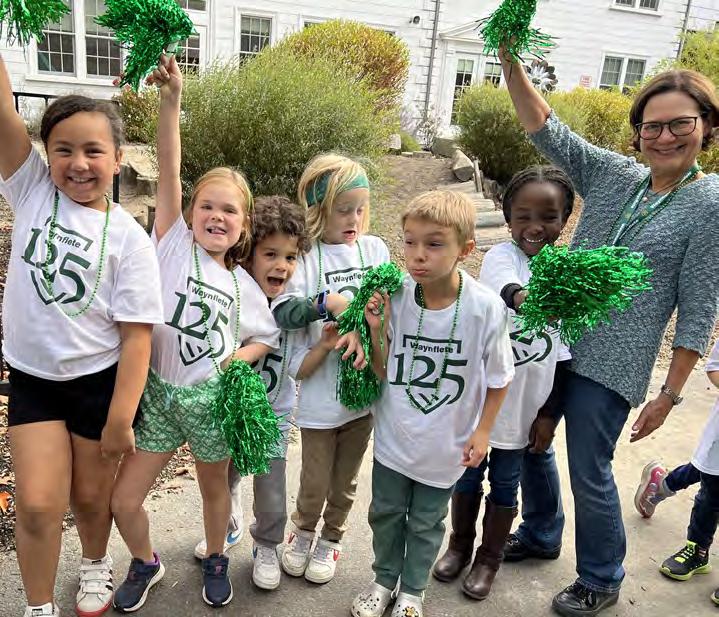

More than a century later, Waynflete’s mission and core beliefs continue to guide everything we do.
We are not content to rest on our laurels, however. We recently undertook the important work of articulating a Portrait of a Graduate (see page 48)—a compelling vision of the knowledge, skills, and qualities we aim to instill in all the children we teach. The portrait calls on students to be curious and courageous learners, agile and resilient problem solvers, innovative and imaginative creators, and collaborative leaders and changemakers. It is a high bar but one that I am confident our students can reach if they have the support of our dedicated faculty and staff.
Financially, Waynflete is on solid footing. Our enrollment was strong this year, with 585 students, and our endowment stands at $30 million. While tuition provides the majority of our revenue, our commitment to access and affordability remains steadfast. We devote more than $5 million annually to financial assistance, ensuring that a Waynflete education is within reach for families from a wide range of socioeconomic backgrounds.
We are constantly assessing and renewing our programs to ensure that we are meeting the needs of our students and preparing them for the world they will inherit.
And while our commitment to educational excellence goes beyond any single subject area, we made a strategic decision in recent years to expand our curricular STEAM offerings. The results have been remarkable. We have gone from having only a handful of Upper School students enrolled in computer science to nearly 200 students engaged in engineering and computer science classes across our divisions. Led by faculty member and alumnus Jon Amory ’97, Waynflete students and their Outliers teammates placed in the top 1 percent of teams at the recent FIRST Robotics world championships.
Waynflete is also deeply committed to fostering a strong sense of community and belonging among our students, faculty, and staff. We have made a concerted effort in recent years to measure and strengthen our community’s sense of connectedness and inclusivity. While we are heartened by the progress we have made, we recognize that there is always more work to do in this area. We will continue to prioritize initiatives that bring us together, celebrate our diversity, and ensure that every member of the Waynflete community feels seen, heard, and valued.
As we look to the future, we are excited about the possibilities for enhancing our facilities to support our ambitious educational and community-building goals. Last year, we engaged a local
architectural firm to help us take a fresh look at our campus and identify opportunities for growth and improvement. One of our top priorities is to develop a new dining facility that will serve as a hub of community life and transform the way we gather over shared meals. We will also build a state-of-the-art Wellness and Athletic Center that will provide not only much-needed gym space but also dedicated areas for health and wellness classes, events, and gatherings.
None of these plans would be possible without the strength of our community. Waynflete draws students, parents, and employees from a remarkably wide radius, with members of our school family hailing from more than 50 towns across southern Maine. We are particularly proud of the racial and cultural diversity of our student body, with 23 percent of our students identifying as students of color—a figure that distinguishes Waynflete from other independent schools in our state.
As I look ahead to the next 125 years, I am filled with hope and excitement. Waynflete’s future is bright, thanks to the strength of our mission, the talent and dedication of our community members, and the clarity of our vision for the future. We will continue to challenge minds, nurture spirits, and graduate young people of character and conviction who are prepared to lead lives of meaning and purpose in an ever-changing world. It is an honor and a joy to be part of this important work. Thank you for joining us on the journey.
Geoff Wagg Head of School
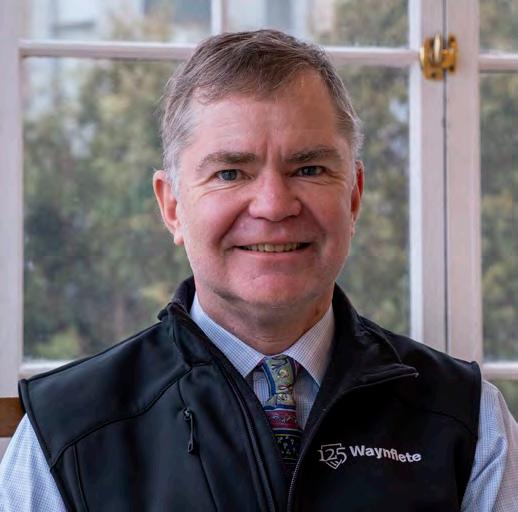
CELEBRATING OUR PAST BUILDING OUR FUTURE
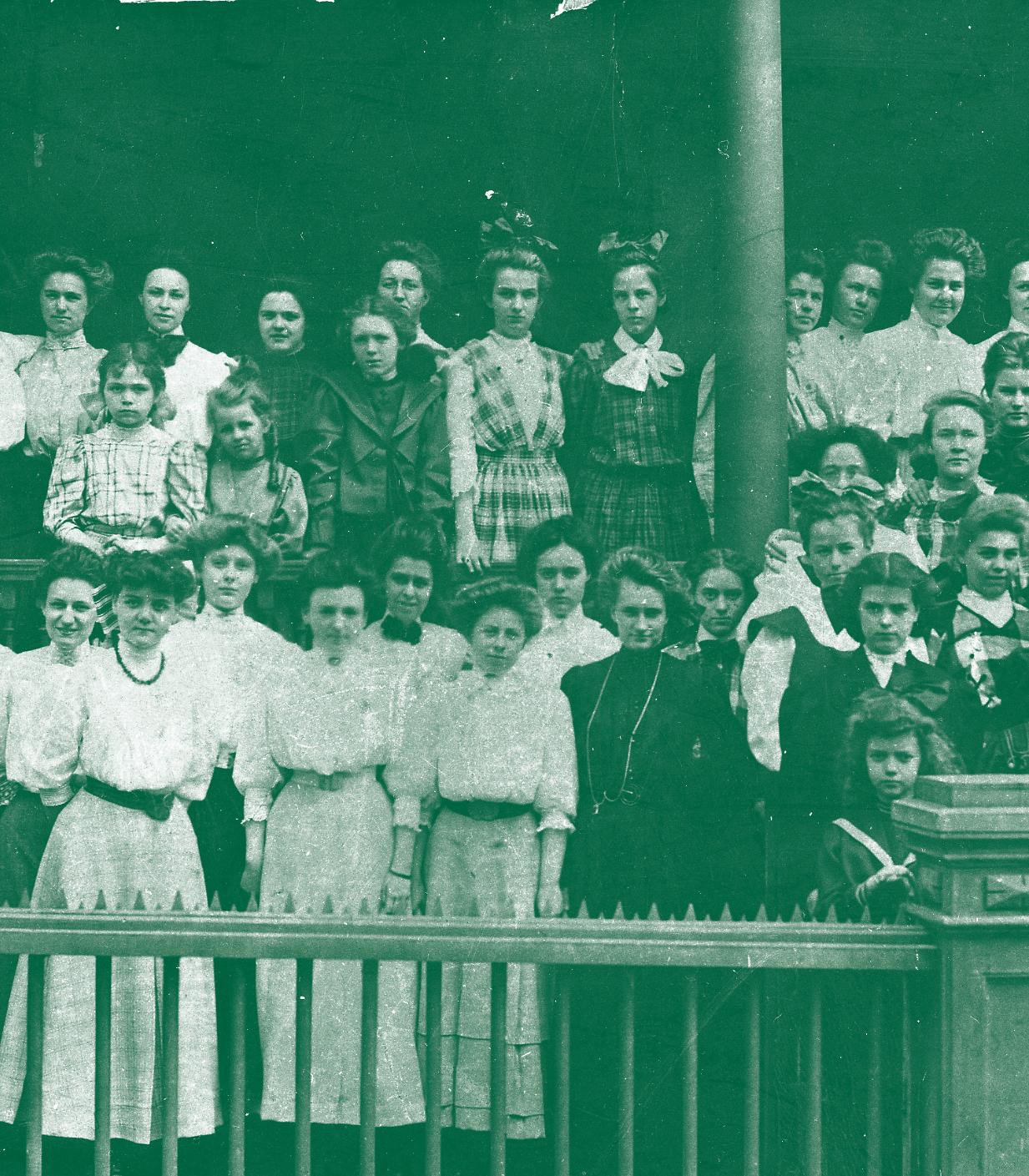
Highlights of Our
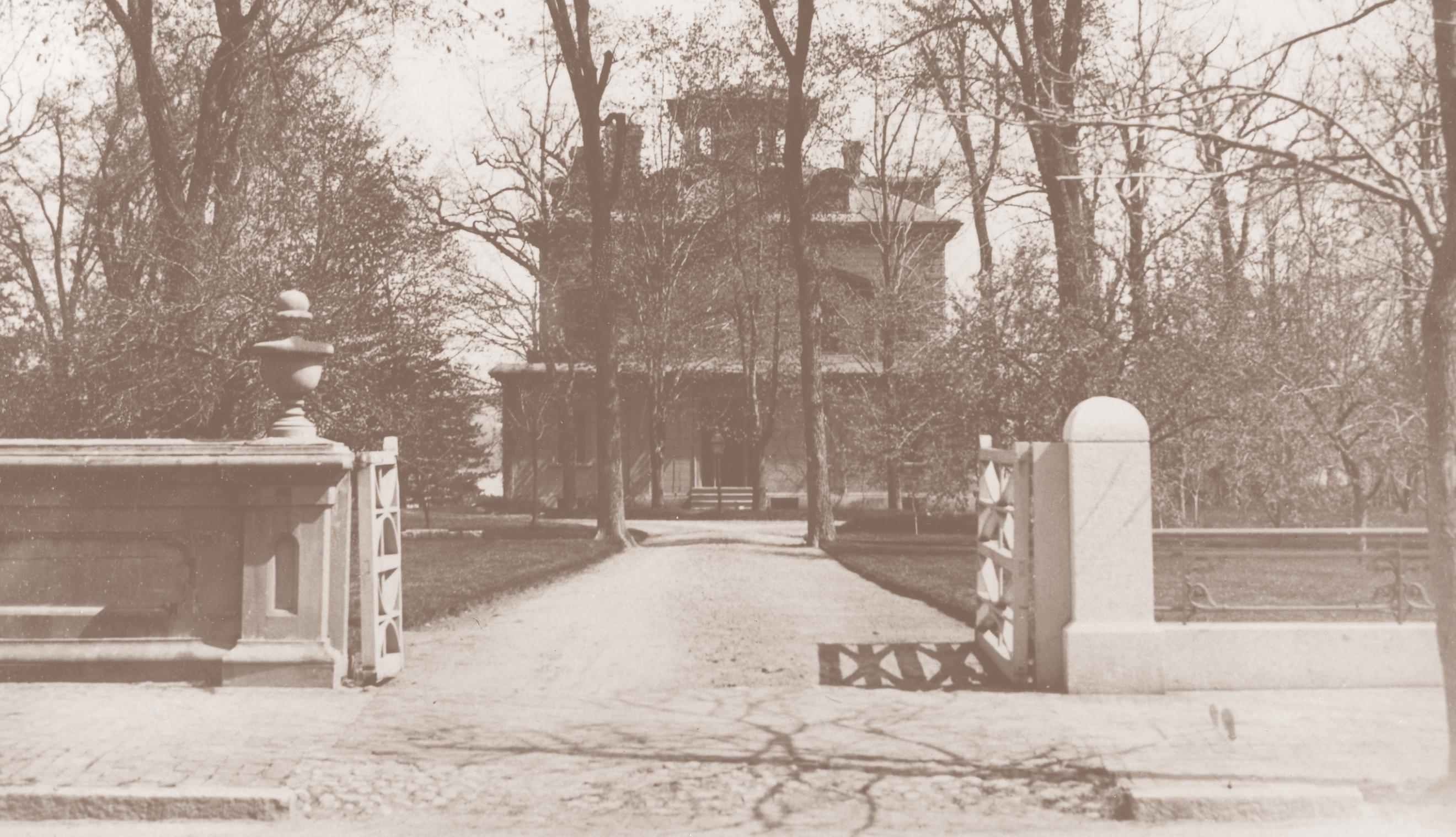
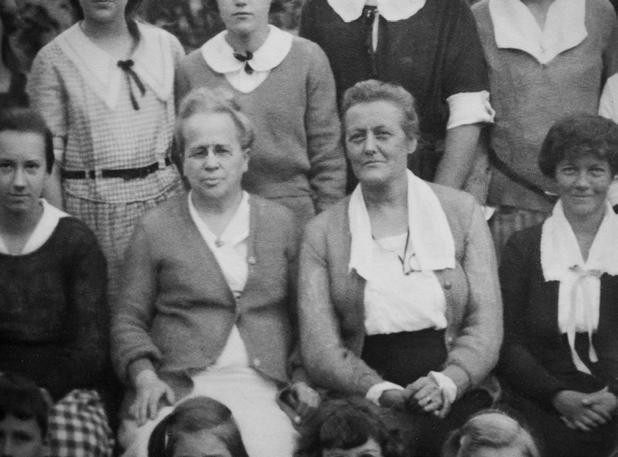
Libby MacDonald Bischof, Ph.D.
Reflecting on the Legacies of Agnes Lowell and Caroline Crisfield
In September 1898, Ms. Agnes Pennell Lowell (1868-1939) and Ms. Caroline Martin Crisfield (1860-1947), then 30 and 38 years of age, respectively, jointly opened The Portland School for Girls in the former Elias Thomas House, a mansion built in the Federal style on Danforth Street in Portland’s West End neighborhood. The new educational institution was a successor to the Bellows School, run for many years by the Reverend and Mrs. John Bellows. Ms. Lowell and Ms. Crisfield, both experienced educators, intended to offer young women a secondary education, preparing them for further study in a growing number of colleges and universities open to women at the turn of the century. When their doors opened, Ms. Lowell and Ms. Crisfield began with 49 students, mostly young women, but from the outset, they admitted boys to the younger classes of five- to seven-year-olds.
Soon after its founding, the school gained a more distinguishing name. The very next year, after returning from an inspiring trip abroad to England, the principals renamed their school Waynflete, after the 15thcentury Bishop of Waynflete, who was also founder of Magdalen College at Oxford. As Jessie Churchill Thompson, Class of 1908, recalled: “The name ‘Waynflete’ came after about the first two years. Miss Crisfield and Miss Lowell had been abroad and had become interested in the history of William of Waynflete, who was Bishop of Winchester…. [They] brought back that name, and one or two others, and the girls voted to call the school ‘Waynflete.’” Indeed, by 1899, local newspaper advertisements noted the name change, and by the fall of 1900, the school’s third full year, the founders were training “a large college preparatory class,” according to the Portland Evening Express
As the school continued to grow in both size and reputation, a series of new locations had to be found to accommodate the boarding and day students. The founders first moved
Waynflete to 65 State Street in 190102, before purchasing the much larger Oakland Estate, then owned by Horace Dudley, located at 360 Spring Street, in 1912. Although they sold the Dudley Mansion in 1922, they retained the schoolhouse (formerly the estate’s horse stable and carriage barn) and the grounds, which remain the heart of Waynflete’s 21st-century campus today. The old schoolhouse is now called Founders Hall, renamed in 1965 in honor of Lowell and Crisfield.
Portland was a bustling commercial port city with extensive international rail and steamship networks at the turn of the century, when Lowell and Crisfield established their new school during the height of the Gilded Age and of Maine’s industrial expansion— especially the lumber, paper, shoe, textile, and granite industries. This was also an era that witnessed Maine’s growing tourist economy and its early identity as Vacationland. With a burgeoning population of nearly 50,000 by the time of the 1900 census, Portland had long since recovered from the Great Fire of 1866, which destroyed numerous homes and commercial
buildings throughout the city and had entered an era of park building and beautification as part of the national City Beautiful movement. By 1900, the city was also home to a plethora of public and private primary and secondary schools, all of which can be found listed in the Portland city directory, published annually. In 1873, the Maine Legislature passed the Free High School Act, which required towns to either establish public high schools supported by state funds or to pay tuition to private academies to educate their residents (this arrangement is still in effect). Portland High School was established in 1821, the year after Maine gained its statehood, and Deering High School opened in 1874, after the Free High School Act. Given the increasing availability of free public high school throughout the city and state, Waynflete’s continual growth and expansion as a tuition-based private school, in an era when many longestablished academies closed their doors when they couldn’t compete with the free secondary education now provided to citizens, speaks volumes about the quality of education
being offered by Ms. Lowell and Ms. Crisfield, as well as the integration of their school into the everyday life of the West End.
Ms. Lowell and Ms. Crisfield had a notable impact on their young scholars—both in their teaching and through the examples set in the exemplary lives they led as independent women and established educational leaders in New England. By the early 1900s, the two founders were already advertising in the local papers that young women who sought their secondary education at Waynflete and graduated with their degrees were now attending Wellesley, Mt. Holyoke, Vassar, and Bryn Mawr Colleges, among the most elite women’s colleges in the country. This was possible largely due to the founders’ own experiences as educated women and the progressive and comprehensive education and training provided by the faculty at Waynflete.
But how did these two women come to co-found a school in Portland, Maine, a city with a notable litany of important schools for women, such as the Misses Martin’s School for Young Ladies (1803-1834)? Ms. Lowell was born in 1868, during America’s Reconstruction era, and was raised far from Portland, in Calais, Maine, the daughter of a prominent businessman. In 1890, at 22, she left Downeast Maine for Radcliffe College in Cambridge, Massachusetts, and in 1892 she went on to take a position teaching English at the prominent Ogontz School for young women, located just outside Philadelphia, where she met Ms. Crisfield. Crisfield, the elder of the founders, was born just prior to the start of the Civil War, in 1860, and was raised in Princess Anne, Maryland. Her father was a Civil War colonel and later a congressman and confidant of President Lincoln. She
Ms. Lowell and Ms. Crisfield had a notable impact on their young scholars—both in their teaching, and by exemplary lives they led as independent women and established educational leaders in New England.
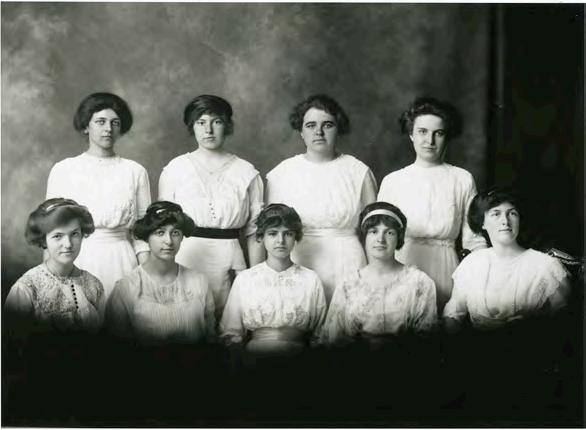
went to Swarthmore College in 1888, graduated in 1890 (possibly as the first woman in her Maryland county to receive a college education), and left in 1891 to take a position teaching mathematics in New Jersey prior to arriving at Ogontz in 1892, where she taught mathematics and where Waynflete’s eventual founders met one another.
Lowell and Crisfield taught at Ogontz together for six years, between 1892 and 1898, when they moved to Portland, Maine, to found their own school. At the Ogontz School, young women between the ages of 13 and 18, largely from wealthy families all over the United States, studied liberal arts, humanities, and physical education (complete with military drilling). Ogontz was well known by prominent families as an elite boarding and day school and had also gained a reputation as a finishing school. While Lowell and Crisfield were on the faculty, Mary L. Bonney and Harriette A. Dillaye were joint principals, providing Waynflete’s founders with a model of what they could accomplish in Maine. Indeed, one need only look at photographs of Ogontz in the early 1890s to see just how much their formative time there influenced both the ethos and the aesthetic of what Lowell and Crisfield built together in Portland in the West End between 1898 and when they retired from their positions in 1924.
After Waynflete, Ms. Lowell bought a farm in Falmouth, Maine, where she and Ms. Crisfield spent summers. The younger Ms. Lowell continued to teach for a few more years, primarily at the Misses’ Kirk’s College Preparatory School in Bryn Mawr, Pennsylvania, where she was accompanied by Ms. Crisfield. Given their lifelong companionship, we might deduce that Ms. Crisfield and Ms. Lowell had what was then referred to as a
“Boston marriage,” a nontraditional domestic relationship between two middle- or upper-class women that was quite common in New England in this era. Like Waynflete’s founders, women who were involved in Boston marriages were typically college educated, financially independent, and were working in fulfilling careers of their own. The two women wintered in Princess Anne, Maryland, with Ms. Crisfield’s sister Mary, until Agnes Lowell died of a stroke in April of 1939. Upon her death, she left the Falmouth Farm, along with a $10,000 bequest, to Ms. Crisfield. Caroline Crisfield died seven years later, at 86, after a long illness, in July 1947. Agnes Lowell and Caroline Crisfield are buried side by side in the Manokin Presbyterian Church Cemetery in Princess Anne, Maryland, in the Crisfield family plot.
In the spring of 1924, at the schools’ annual graduation ceremony, Waynflete faculty, students, alumni, and families celebrated the long careers of the school’s founders. On the eve of their retirement, their former student Elizabeth Marshall (Class of 1919) spoke on behalf of generations of young people when she honored her mentors in front of the graduating class of 1924: Had your influence upon us ended with the gift of good schooling, we should have cause to be thankful to you. But it did not end with that. In addition, you constantly impressed us with the fact that we were women of a privileged class, and because of our privileges we owed certain obligations to society. You taught us the significance of the chivalric legend and noblesse oblige, and showed us that it was incumbent upon us to set a high standard of conduct. In this way, you awakened in us a sense of social responsibility.
One hundred years later, in 2024, during the 125th anniversary of Waynflete School, Marshall’s words ring true for both alumni and current students—Waynflete students of all ages are held to high standards, and harbor a strong sense of social responsibility, as evidenced in the school’s current mission: “To engage the imagination and intellect of our students, to guide them toward selfgovernance and self-knowledge, and to encourage their responsible and caring participation in the world.”
The legacy of the founders is alive and well, as their own pathbreaking careers serve as an inspiration to generations of young people educated at the institution they founded in 1898.
Libby Bischof is professor of history and executive director of the Osher Map Library and Smith Center for Cartographic Education at the University of Southern Maine. She wishes to acknowledge the excellent research done on the history of Waynflete in 1998, during the 100th anniversary, and published in Celebrating Waynflete: One Hundred Years in the Life of a School, by Leonard L. Brooks and Margaret W. Soule.
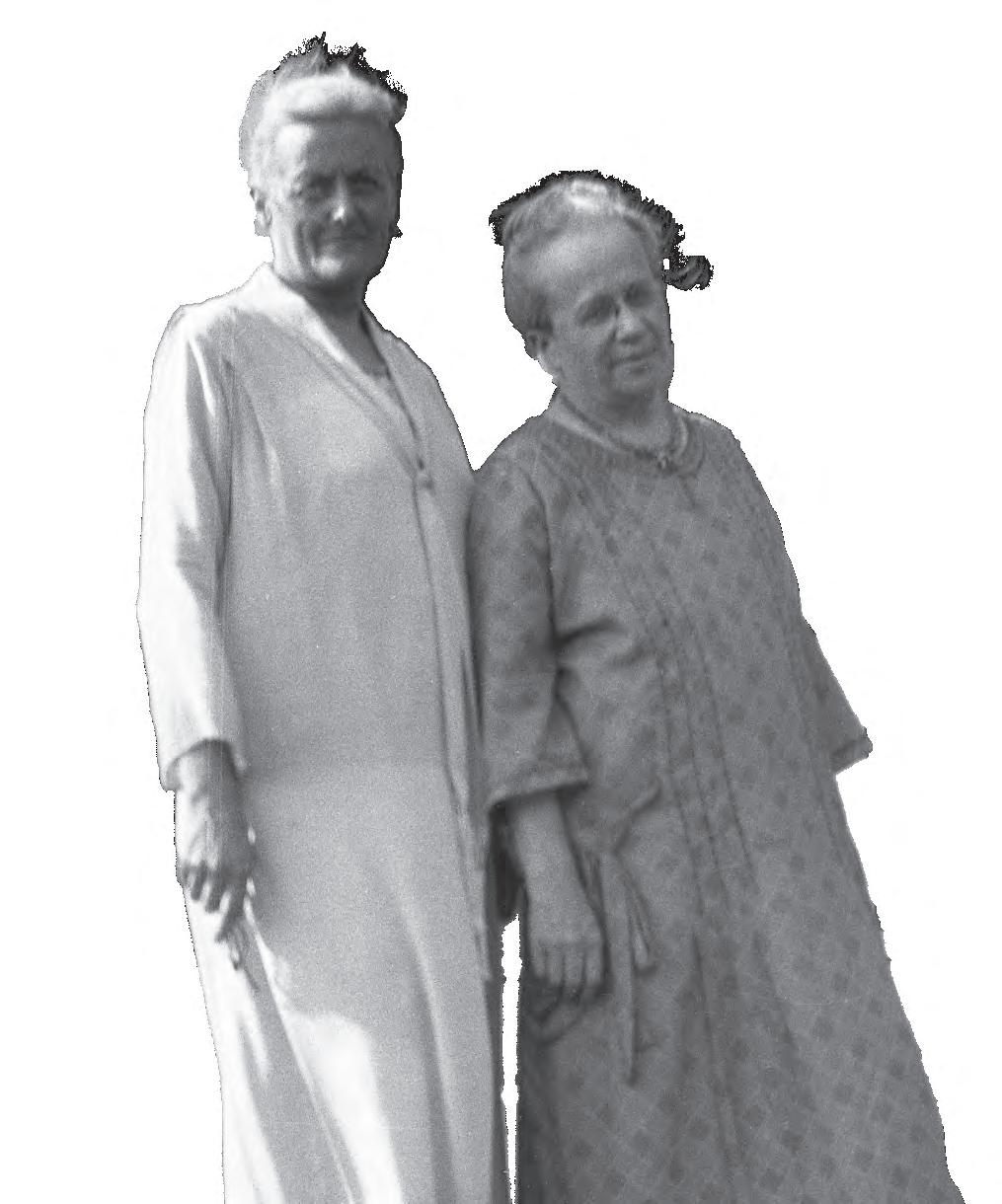
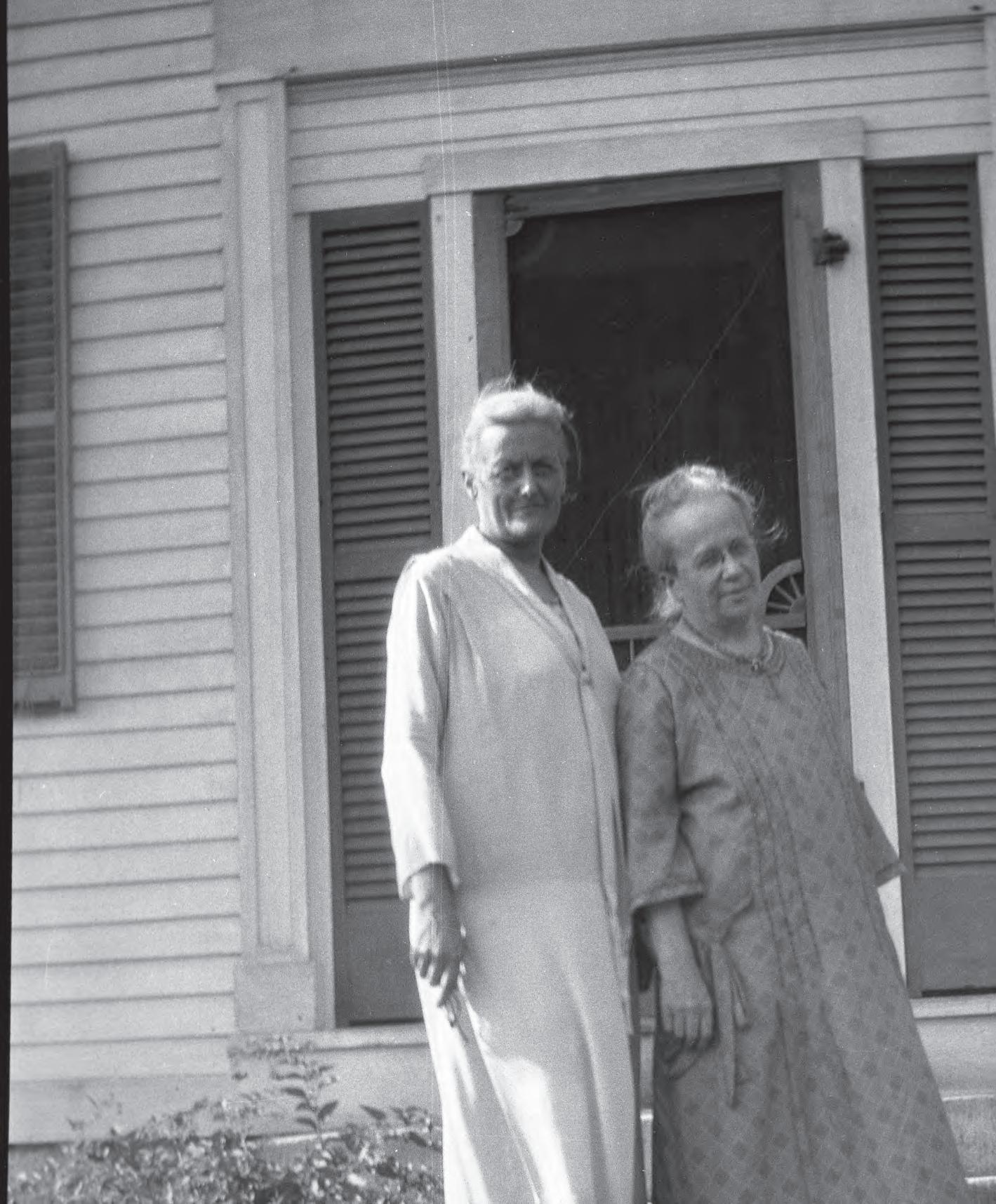
In 2017, as the school prepared to embark on a capital campaign to build a new Lower School, former Waynflete parent and trustee Deborah Shinn took on the role of curating “Building Waynflete,” a gallery exhibit that showcased the architectural history and evolution of the school’s original locations and its modern-day structures. Shinn, who has an extensive background working in museums such as the MFA and the Smithsonian’s Cooper Hewitt Design Museum, worked in collaboration with former visual arts chair Judy Novey, current chair Jona Rice, former Development Director Sarah Plimpton, and Jamie Kingman Rice from the Maine Historical Society. Drawing on Waynflete’s archive and historical maps from USM’s Osher Library, Shinn’s research explored the origins of the buildings that now comprise the Waynflete campus. One of the more intriguing discoveries Shinn made during her research was the role played by renowned architect John Calvin Stevens in shaping today’s campus. A prominent figure in the architectural landscape of Portland, Stevens was found to have designed or renovated eight of the buildings on the school’s Spring Street campus. We are indebted to Shinn for her role in bringing Waynflete’s history to life. HISTORIC PHOTO ATTRIBUTIONS APPEAR ON PAGE 33
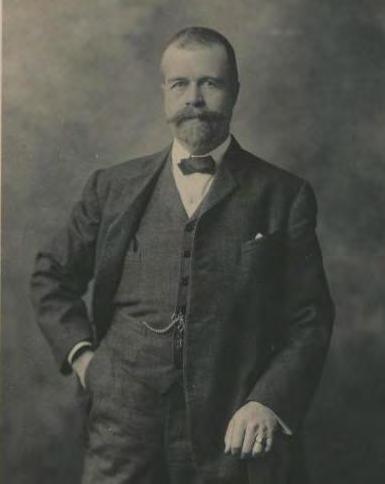
John Calvin Stevens (1855-1940), Portland’s most famous architect, designed or remodeled eight of the buildings occupied by The Waynflete School. Stevens began his career working under Francis Fassett (architect of 64 Emery Street) and then opened his own practice in 1884. He had a long career working in many architectural styles, from High Victorian to Colonial Revival, but is best remembered as an originator of shingle style design (for example, Boulos House and the 3 Storer Street House). He and one-time partner A.W. Cobb published an influential design book titled Examples of American Domestic Architecture (1889). Stevens was also active in civic affairs and promotion of the arts in Portland. The architectural firm he founded, SMRT, still exists in Portland today.
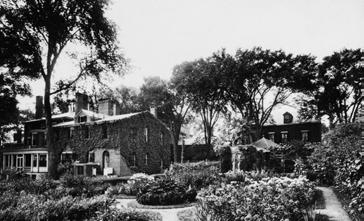
The first home of The Portland School for Girls in 1898 was the Elias Thomas House at 163 Danforth Street, where the school remained for two years. The property, which is considered one of Portland’s grand Federal style mansions, is now known as The Danforth Inn.
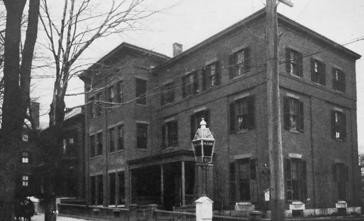
In 1900, the school purchased a large brick building on the corner of State and Danforth Streets. At the same time, the school’s name was changed to The Waynflete School, in honor of noted British educator William of Waynflete, founder of Magdalen College at Oxford. The State Street building no longer stands— its site is now a parking lot.
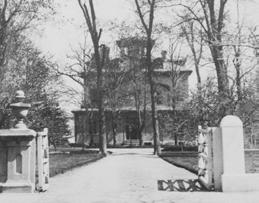
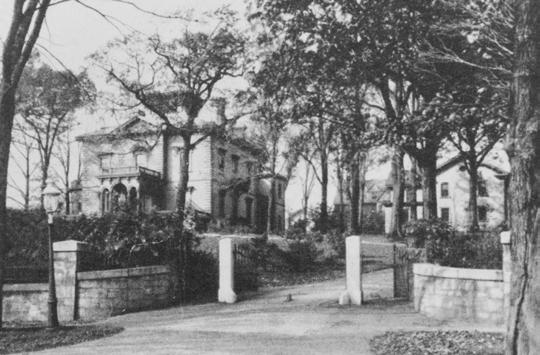
Two of the West End’s larger estates both became part of the Waynflete School campus. Oakland is shown above with its residence, stables, and greenhouse outlines amid winding driveways and garden paths. The driveway shown in the inset photo is now used to enter Thomas House, which had not been built at the time of the photograph (the granite post and iron fence at the right of the photo still border the driveway). The main entrance to Oakland was from Danforth Street. The building to the right of the house is the stable, which later became the Waynflete Schoolhouse—now Founders Hall. The stone wall that borders the grounds on Danforth Street remains there today.
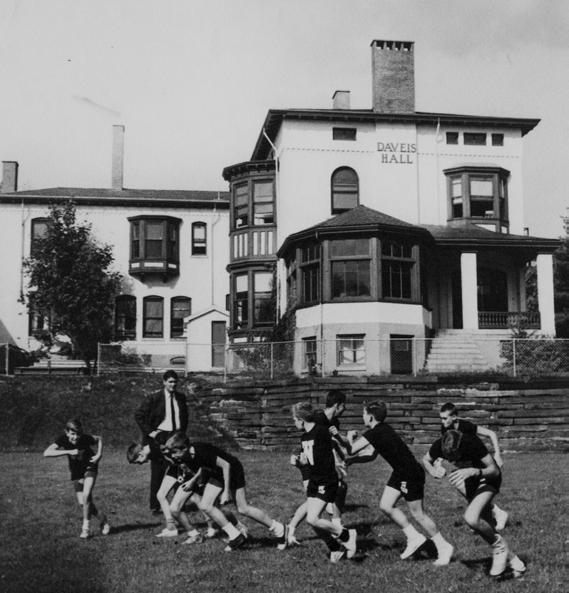
Today, Daveis Hall is home to Waynflete’s music, theater, and studio arts programs. The house was built in 1860 in an Italianate style and has been modified several times over the years. The original owner was Henry Hart Furbish (1835-1913), whose fortune came from the sugar refining and lumber industries. When Waynflete acquired the building in 1942, it was known as the Baxter-Moyer Residence. The school named it Waynflete House and then in 1955 rechristened it Daveis Hall, in honor of a generous gift from the Edward H. Daveis Benevolent Fund.

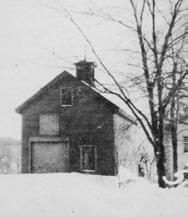
Ruth Cook Hyde House is one of the three houses that make up Waynflete’s Middle School. Built in 1860-62, the structure has a Mansard roof and dormer windows with scrolled frames that are common features of the Second Empire architectural style. Ruth Cook Hyde (1893-1986), Waynflete Class of 1910, grew up in the house and ultimately bequeathed it to the school. The garage behind Ruth Cook Hyde House was originally a barn where Ruth Cook kept her pony. In 1962, she donated the yard just behind the garage to the school for use as a quiet area, now known as the Sanctuary. The garage remained part of the campus until 2003, when it was replaced with a new Middle School playground.
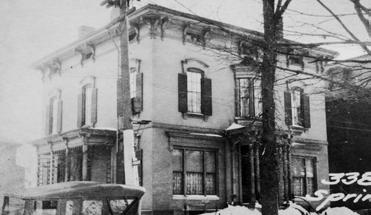
Morrill House, built in 1867-68, is an Italianate style residence. The house was purchased by Waynflete in 1963 and used initially as a dormitory for boarding students. Later, Morrill House was home to the kindergarten, music room, dance studios, and faculty apartments, before eventually becoming part of the Middle School center. The building was named in honor of George Burnham Morrill Jr., an active parent and committed community member who served as president of the school’s board of trustees in the 1950s and 60’s.
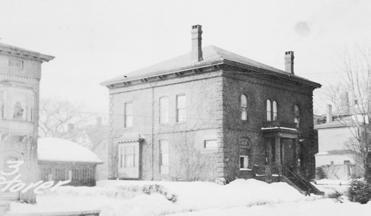
Hurd House was built in 1867-68 in an Italianate style. Waynflete purchased the house from the Hurd family in 1965, and for the next 20 years it was the headmaster’s residence. Later, the building housed administrative offices and foreign language classrooms and finally became part of the Middle School.
A prominent figure in the architectural landscape of Portland, Stevens was found to have designed or renovated eight of the buildings on the school’s Spring Street campus.
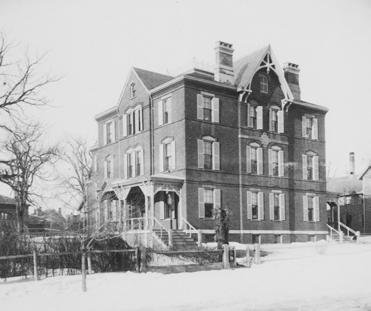
64 Emery Street was constructed in 1871 as the Home for Aged Women. Francis Fassett, Portland’s renowned architect of the High Victorian style, designed the building. John Calvin Stevens later designed two additions. In 1975, the facility moved to 75 State Street, and the Emery Street building became Walrick Estates, a retirement residence for women and men. Waynflete School purchased the Emery Street building in 1984 and it became the Upper School Center.
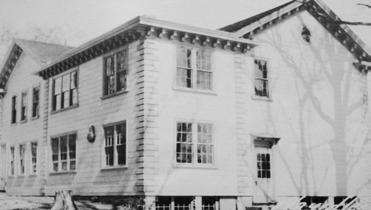
Founders Hall, now home to Waynflete’s Lower School, was originally the horse stables and carriage barn for the Oakland Estate. Classrooms were established in the building when the Waynflete Latin School purchased Oakland in 1912. Waynflete sold the Oakland mansion in 1922 but retained the schoolhouse.

Thomas House, built in 1890, was designed by architect Albert Winslow Cobb while in partnership with John Calvin Stevens. The original owner was Sidney Warren Thaxter, a prosperous Portland flour and grain merchant. It was later owned by William Widgery Thomas, a prominent Portland banker and businessman whose daughters, Mary Louise ’46 and Zella ’49, graduated from Waynflete School. The family later donated Thomas House to the school.
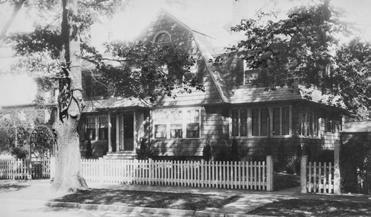
The house at 305 Danforth Street was built in 1923. Boulos House became part of the Waynflete campus in 1996 and is the current residence of the head of school. It was named in honor of the Boulos family, major supporters of the school.
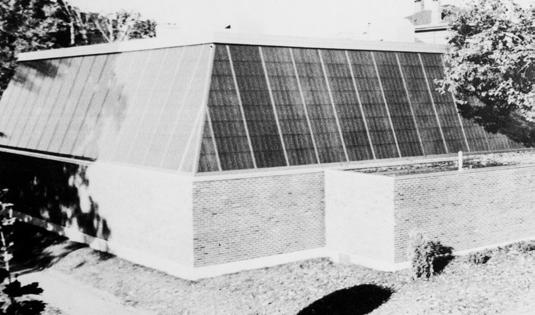
Opened in 1974, the gym was the first new freestanding building constructed on the Waynflete campus.

The Waynflete community is indebted to Judith Piper Osgood ’52, Lenny Brooks, and Margaret Soule ’59, whose work documenting the school’s history is a sign of their shared passion and commitment.
LENNY BROOKS recently shared his recollections of co-authoring, with Margaret Soule (a former head of alumni relations and publications), the book Celebrating Waynflete,” which was published on the occasion of the school’s 100th anniversary. Brooks dedicated nearly two decades to Waynflete, starting in the early ’70s as an English and history teacher, before eventually taking on the role of Middle School director. His passion for the school’s history—and his habit of incorporating that history into his curriculum—caught the attention of former headmaster Bill Bennett, who enlisted him to contribute to the landmark project.
Brooks and Soule embarked on a yearlong journey of researching, writing, and conducting interviews. “Maggie and I would work at our own pace,” Brooks recalls. “Then we’d have work sessions where the time was given over to the book and the writing of it.” One of the significant challenges they encountered was the absence of a central archive; historical materials were scattered in various locations across the campus, including the library, development office, and Soule’s office. The two drew on valuable groundwork laid by Judith Piper Osgood, Class of 1952, the school’s first alumni secretary and development director. According to Brooks and Soule’s preface to Celebrating Waynflete:
In 1967, as Waynflete’s seventieth anniversary approached, [Osgood] compiled materials, wrote letters, and interviewed early graduates, with a school history book in mind. In 1981 she and her husband, trustee Dave
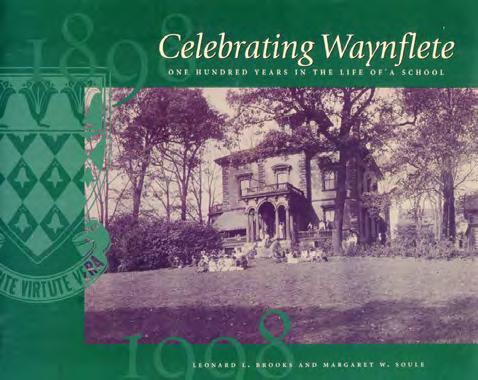
Osgood—parents of two Waynflete daughters—shared the Drake Award for outstanding service to the school.… Thanks to the stewardship of her successors in the realm of alumnae/i and development, her work survives. Through the process, Brooks gained a profound appreciation for the individuals who stepped forward during challenging times to ensure the school’s survival. He described the book as a labor of love and was delighted to learn that it remains a cherished resource among staff members today.
Celebrating Waynflete is available from the Thaxter Library for community members to borrow.
A history of proposed moves and mergers over the years, excerpted from Celebrating Waynflete:
The move west from Danforth and State Streets to Spring Street in 1912 was long regarded as providing Waynflete students the best of two worlds, the rural and the urban. But with the advent of Waynflete Latin School and its philosophy of progressive education, the powers-thatbe began to look farther afield than the “two-acre park” between Danforth and Spring. Should the campus be moved to a suburban area? Certainly there would be advantages: plenty of the “fresh air” extolled by progressive educators, and ample room to construct new facilities as well.
A perceived opportunity for such a change—and more—came in 1930 with the proposed merger of the mostly female Waynflete Latin School with the all-male Portland Country Day School.
A Portland newspaper article that fall explained that “the schools will be maintained in separate buildings until the new building is constructed at Stroudwater.” With this apparent plan in mind, Waynflete leased the fortyacre Hawes property off Westbrook Street in Stroudwater in 1930. But the Depression soon dashed the two schools’ plan to merge, and although Waynflete completed the purchase of the land in 1939, only a small field house was constructed there. Soon a war was on, and funds were again tight. In 1942, Waynflete acquired another existing building in its own neighborhood (now Daveis Hall) and remained where it was.
The Stroudwater property remained in the school’s hands until its sale (for $92,500) in August 1956; enthusiasm for its development had apparently waned. Two years prior to that sale, a question had been raised—and put to rest again—about whether or not Waynflete should move to the Marine Hospital campus in Portland’s East Deering neighborhood, just over the Martin’s Point bridge from Falmouth Foreside. In 1958, the purchase of the so-called Perry Cumberland Foreside was also contemplated and rejected. Waynflete made a further commitment to its city location when the Romano property— formerly Oakland, the Dudley mansion—came on the market in February 1959. Waynflete quickly agreed to repurchase the mansion… Neighboring Morrill House, Hurd House and Thomas House were acquired in quick succession; Storer House and a new gymnasium would eventually follow.
By the late 1970s, the school was definitely “on a roll,” but the administration and trustees remained open-minded about the future. After an extended period of dormancy, the issue of cooperative ventures between Waynflete and North Yarmouth Academy reappeared. A joint study committee, appointed in 1979 to review a possible merger of the two schools, met over the course of one year but made no progress
except in the area of transportation. In a cooperative busing initiative, NYA made a northern run to Brunswick, while Waynflete made a southern run into York County. Both routes picked up students for both schools; the exchange of prisoners was done daily at NYA.
During the eventful eighties, the school continued to consolidate its urban campus, purchasing 64 Emery Street and inheriting Ruth Cook Hyde House. At the same time, however, Waynflete’s purchase of thirty-three acres for athletic fields opened up once again, in some minds, the possibility of moving the school. The newly acquired land at Westbrook Farms, a wooded peninsula across the marsh from Thompson’s Point, was one of Portland’s rare undeveloped properties. In March 1992, the Facilities Committee of the Trustees Long Range Planning Committee completed its “Campus Alternative Analysis”—an instructive document. The practical conclusion was simple: “The debt that a new facility [65,000 square feet] will produce even with the sale of the existing campus is quite significant.” The appraisal value of the existing campus was slightly under $3,000,000; the projected cost of a new facility at Westbrook Farms, including related road improvements, parking spaces and the like, came to over $5,000,000. Further, it was pointed out, any savings in maintenance “are likely to be minimal. New becomes old very quickly.”
Read a detailed history of the Fore River Campus at bit.ly/24mag-16.
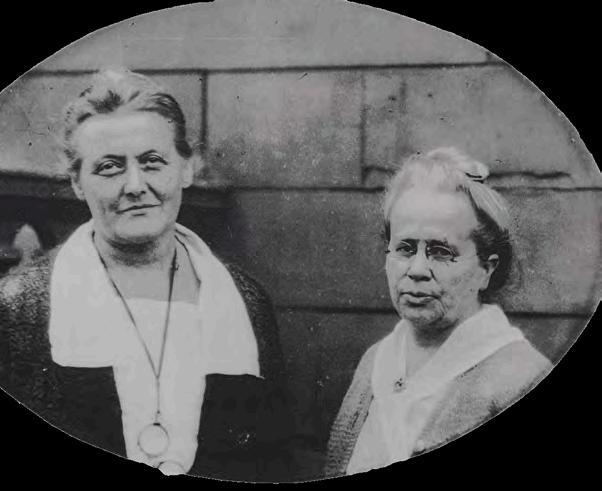
Excerpted from Celebrating Waynflete
IN 1923, as the school neared its twenty-fifth anniversary, Miss Lowell and Miss Crisfield announced that they would retire from their principalship. We can only surmise the factors leading to their decision. Possibly, at ages fiftyfive and sixty-two, they felt a need to ease up: the student magazine Now and Then mentions that Miss Crisfield experienced a “long illness” during the school year 19211922. We also know that in 1922 the founders sold the school property, while retaining use of “the School-House.”
“Since the close of the boarding department in 1918,” Now and Then explains, “the big house [the Dudley mansion] has been a burden of care and expense. The sale, therefore, has lifted a load from their shoulders and left them free to devote themselves to their chosen work.” Lowell and Crisfield now lived at The Sherwood, a local apartment house popular with “maiden ladies” of the time.
Fearing the demise of Waynflete with the pending departure of its founders, a group of interested parents drew up the Articles of Agreement and Association that created Waynflete Latin School in March 1923. Miss Crisfield and Miss Lowell sold their shares of the school to the newly formed corporation and agreed, at a salary of $2,000 each, to stay on for one more year.
“Our best wish for the future of Waynflete is that it may continue for the next twentyfive years with the same success that has marked the last.” — STUDENT EDITOR
“We, of course, are prejudiced” wrote a student editor the following month, “but we cannot help feeling that it will not be easy to find just the right person or persons to take Miss Lowell’s and Miss Crisfield’s place in the life of the school. However, already, earnest efforts are being made in this direction. A corporation has been formed to control the business affairs of the school, and our principals have very generously consented to remain with us for one year until the new management is installed. Our best wish for the future of Waynflete is that it may continue for the next twenty-five years with the same success that has marked the last.”
Assured of their school’s survival, the Misses Lowell and Crisfield embarked in June 1923 on a visit to England and France via Cunard Line. They would return in time for Waynflete’s reopening as Waynflete Latin School in September; Miss Lowell would give several talks at the school about their summer’s trip, and Miss Crisfield would continue her traditional weekly currentevents talks throughout the coming year. In June 1924, having helped the school through its transition, the founders departed. During commencement exercises they were presented with “a large sum in gold” as a surprise gift from Waynflete parents.
Agnes Lowell purchased a farm in West Falmouth. There, for the next fourteen years, she and Miss Crisfield would spend their summers. Before retiring for good, she would teach part-time at the Misses Kirk’s School in Bryn Mawr, Pennsylvania, and the Ransom-Bridges School in Oakland, California. “In June 1924 I supposed that my career was ended,” she once wrote, “but something keeps turning up to be done, and I do it.”
Caroline Crisfield returned to Maryland to live, and her former colleague often joined her there during the winter months. Agnes Lowell died on April 14, 1939, three days after her seventy-first birthday. Miss Crisfield would outlive her younger friend by eight years, dying on July 31, 1947, at age eighty-six.
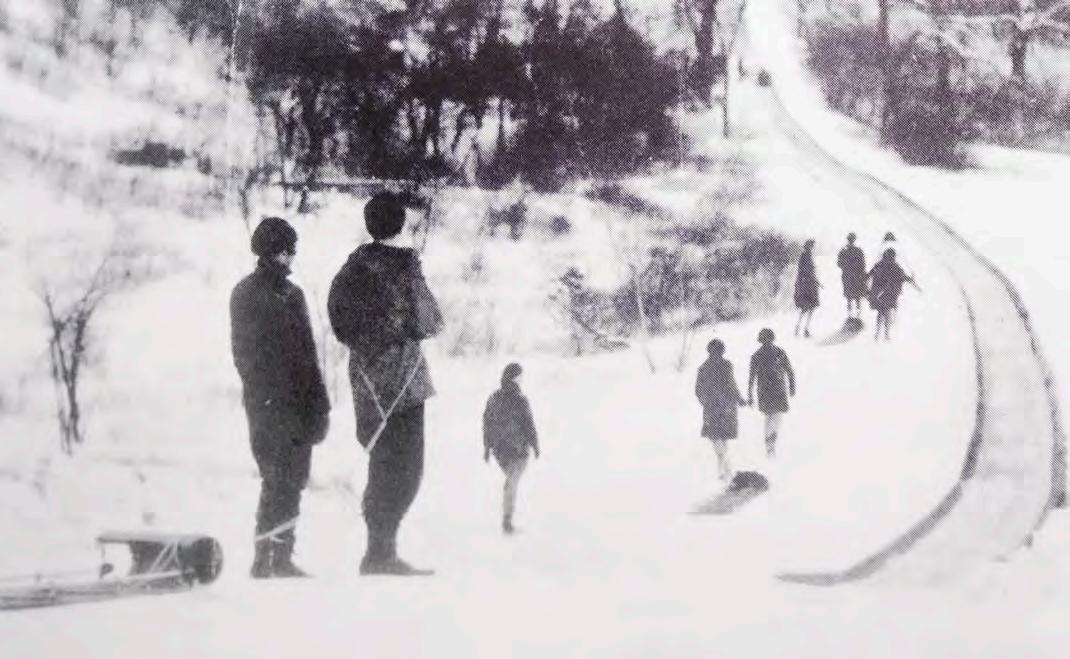

EVEN FOR THOSE who lived in the neighborhood, getting to Waynflete in winter was sometimes a chore. “They didn’t even plow the residential streets,” says Matilda C. Clifford ’30. “People used to put their cars away for the winter... and use the trolley. (It) started at the corner of Vaughan Street and Congress...came right along Vaughan Street to Carroll Street, went down Carroll one block to Neal and then right over to Spring Street.... (After one) heavy snowstorm, nobody was moving, and we walked to school on the car tracks, because it was the only place we could walk.”
Students also hitched rides on pungs, horse-drawn utility sleds with “heavy great big dark-brown wooden runners,” according to Helen Holt Emerson ’26. Depending on the driver’s willingness, “we could get on a runner at the rear of the pung and coast down these little rises, and we thought that was very exciting.” Western Promenade children had many opportunities to do this during “the great ski festival” of the early twenties,
when city-owned pungs went back and forth to dump snow on the ski jump hill.
“Right where the Promenade starts to go downhill, right at the corner of Bowdoin Street...they built this huge scaffolding, about ten feet in from the street, I would say—and this was the start of the interest in skiing in New England, really, or close to the start—and they had Norwegian skiers come over as stars, and then natives competed. But that was why they brought all the snow up,” Matilda Clifford explains. “The takeoff was out over the slope of the hill so that they’d soar,” Helen Emerson says. “You could look way out, and everybody went and lined both sides of the ski jump...” The skiers “just took off over the land and landed down here and ran almost to St. John Street,” adds Matilda Clifford.
Waynfleters also made good use of the celebrated Promenade toboggan chute. “It was further down [than the ski jump], where the slope wasn’t as abrupt. It was long and it wound down slowly. But you got a pretty good speed out of it.... And it was a long walk back up,” Helen Emerson recalls. “That was wonderful fun,” Matilda Clifford says. “We tried to teach our dog to tow the sled back up, but we didn’t succeed.”
Excerpted from Celebrating Waynflete
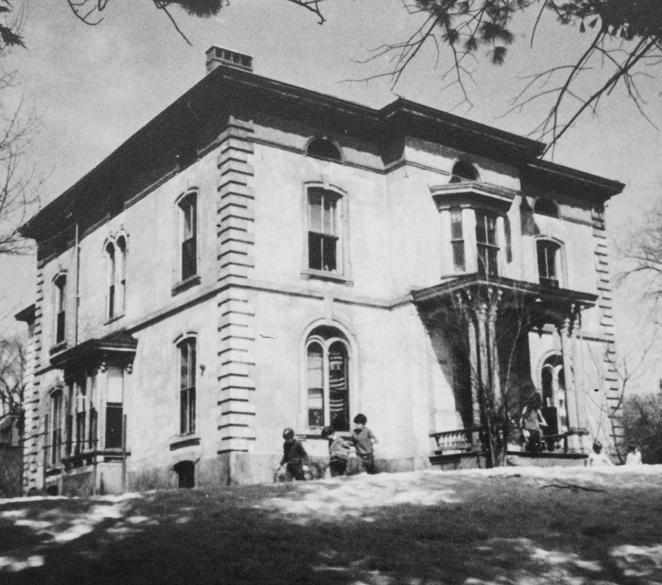
In the early morning hours of February 20, 1987—the last Friday of school vacation— burglars set a fire that gutted Storer House.
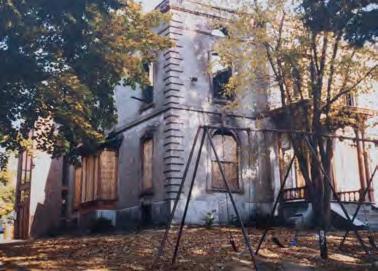


Excerpted from Celebrating Waynflete
WAYNFLETE PURCHASED the Grayhurst estate in 1970 and named it Storer House after its original owner, Horace P. Storer. The estate was acclaimed for its stately house, rose gardens, hydrangea bowers, fruit orchards, and towering trees. Its two grand garden fountains are said to have been the first ones installed in a private residence in Portland.
In the early morning hours of February 20, 1987—the last Friday of school vacation—burglars set a fire which gutted Storer House. As firefighters worked to quell the blaze, assistant headmaster Ron Hall telephoned every Waynflete teacher and staff member, summoning all within reach to the campus. Parents Association president Ann Sanborn Clark ’67 notified parents via “telephone tree”; friends such as former school secretary Marge Dunham also came running. Teams worked all weekend to salvage what they could and to set up classroom space in Emery and Daveis for the displaced Storer House students. By Monday morning, new furnishings and supplies were in place, and on Tuesday classes resumed. Everyone was assured that the Storer House program would go on, in whatever building it might find itself in the future.
Teamwork among the Waynflete community continued throughout the summer with the remodeling of Founders Hall to house the entire Lower School and of Emery to accommodate the Thaxter Library, new Upper School science laboratories, and the Middle and Upper School English and history departments. The damage to Storer House was so extensive, trustees concluded, that the building could not be restored. A plan to put up a performing arts center in its place was presented,
then quickly withdrawn after neighbors objected to the increased traffic it might bring. Major opposition was encountered again from neighbors and historic preservationists when the school, convinced that neither restoration nor replacement was affordable, sought permission to raze the structure. After hearing strong arguments on both sides, the Portland City Council finally allowed the building to be demolished. The wrecking ball descended on June 27, 1988.
Storer House was home to Waynflete’s innovative Lower School program for 19 years. The location where the building once stood is now known as “Waynhenge,” a quiet open space bordered by pine trees and ringed with giant granite blocks that were originally part of the foundations of the Grayhurst mansion.



A few faces and places from our past to our present—a yearbook of learning to learn, side by side and hand in hand, across the years.
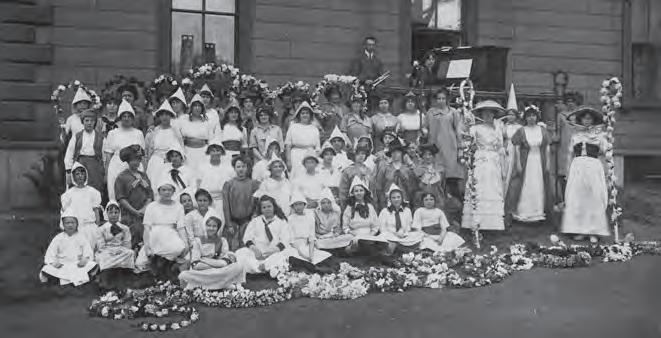
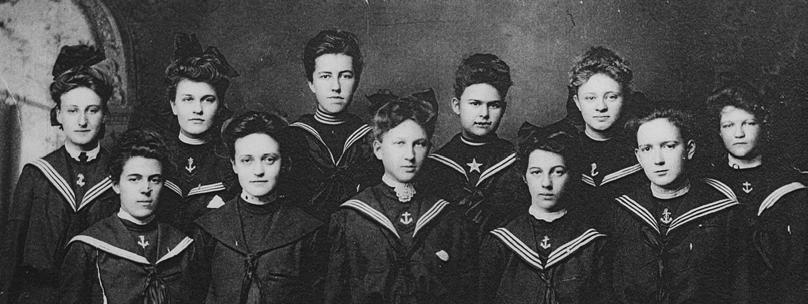

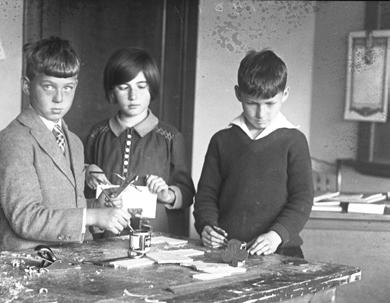
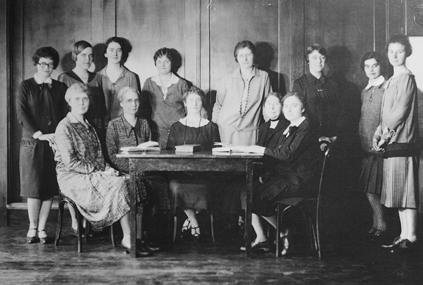
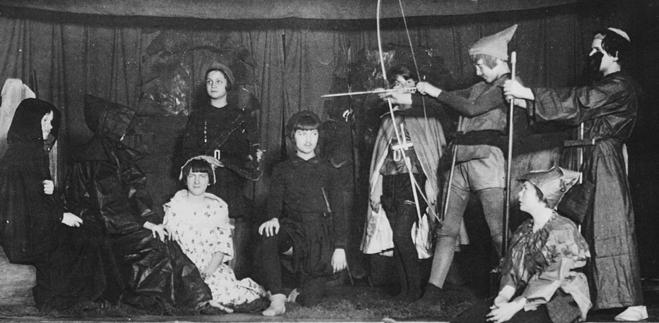

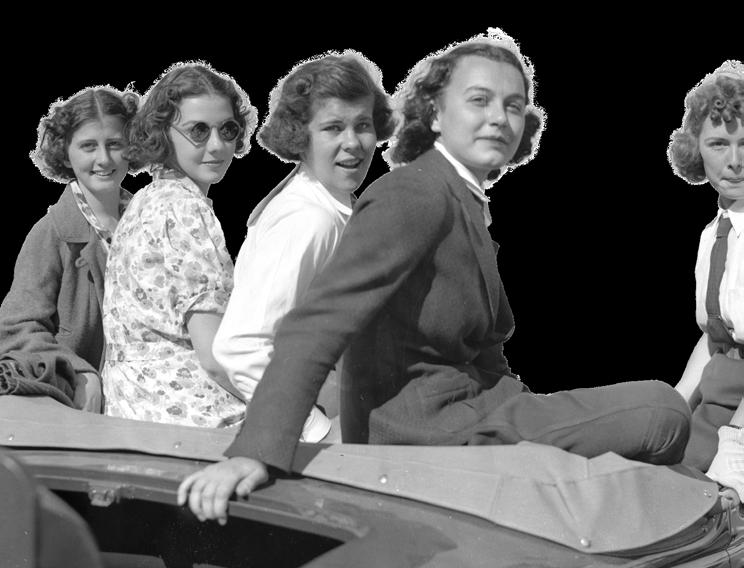

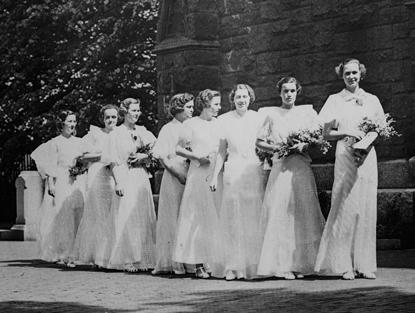
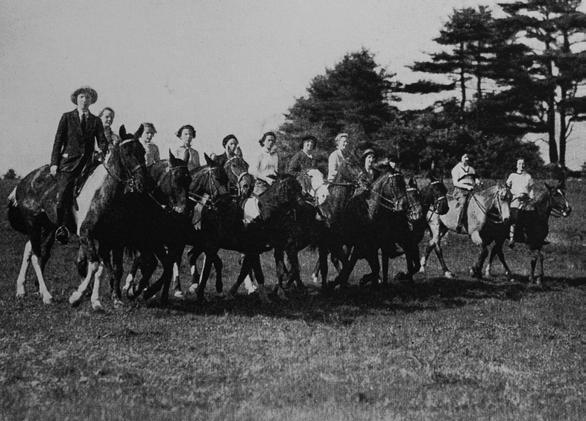
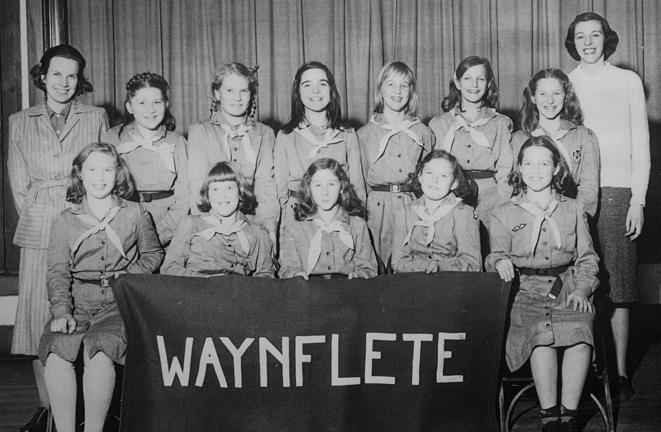
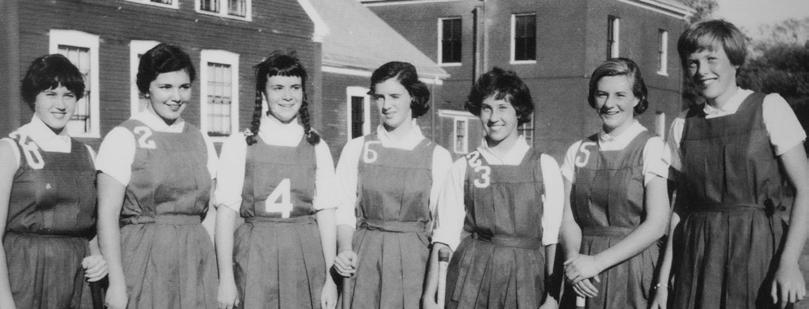
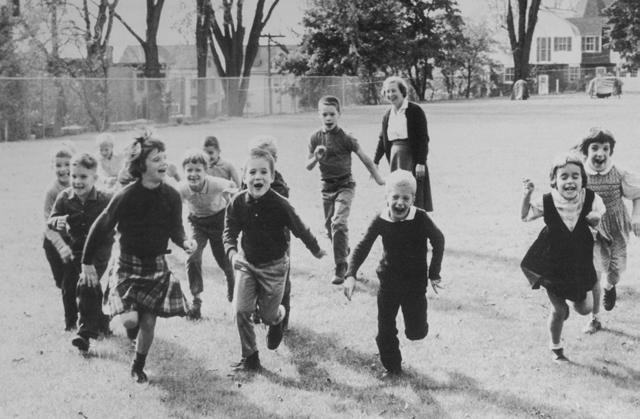
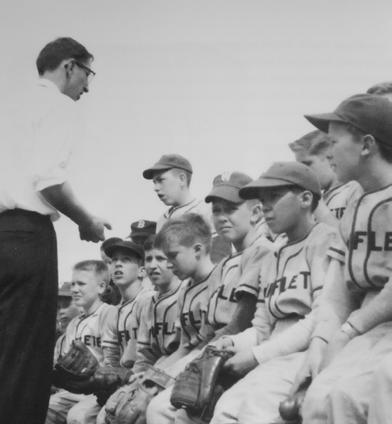

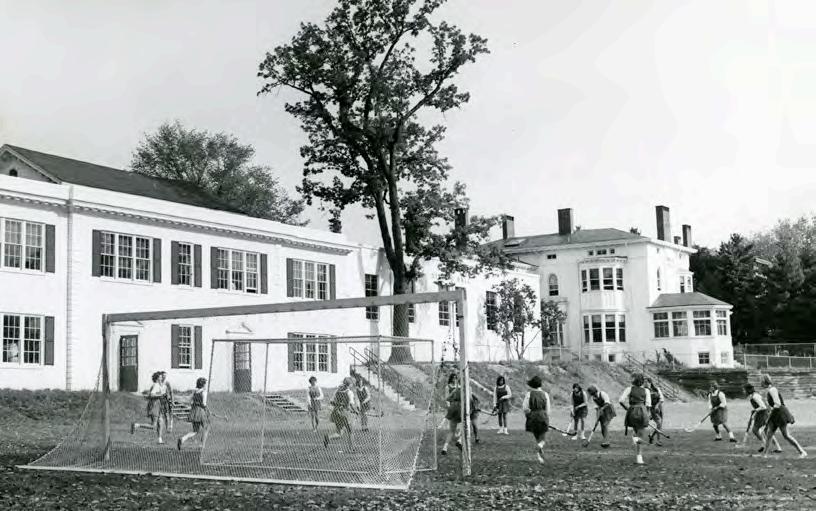
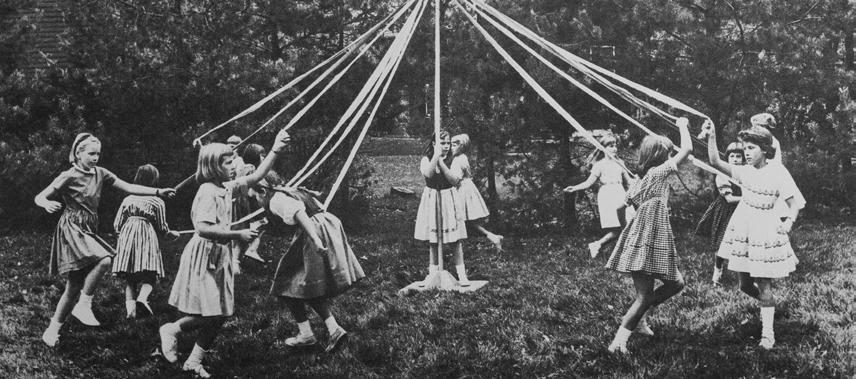
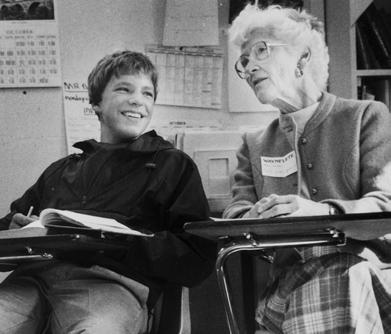
PHOTOS (TOP TO BOTTOM, CLOCKWISE) 1965 field hockey practice in Lower Field, 1983 future class, 1970 Black student organization prepares for Black History Week assembly, 1987 Grandparents Day, c. 1965 Maypole.

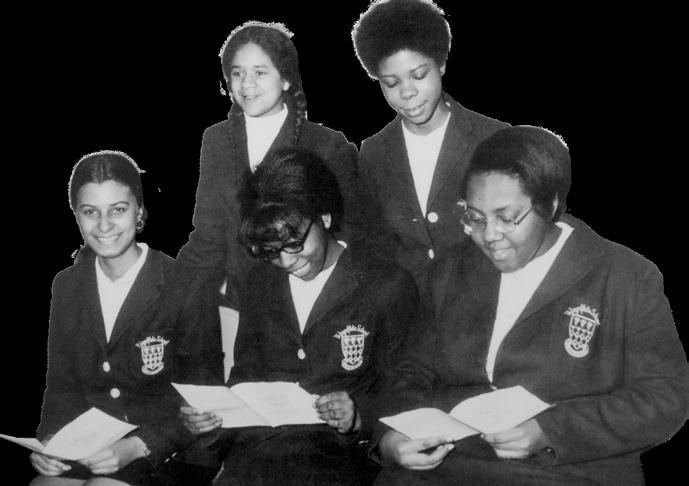
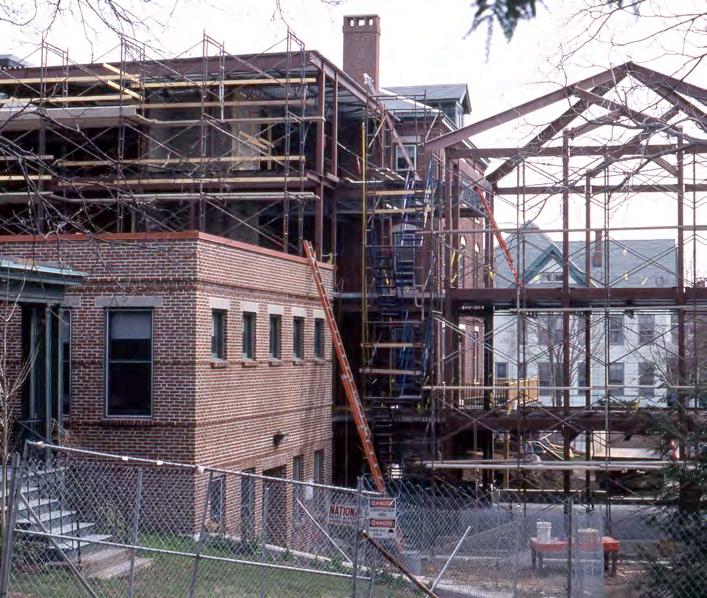
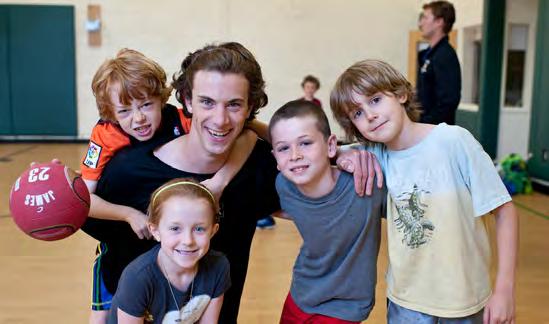

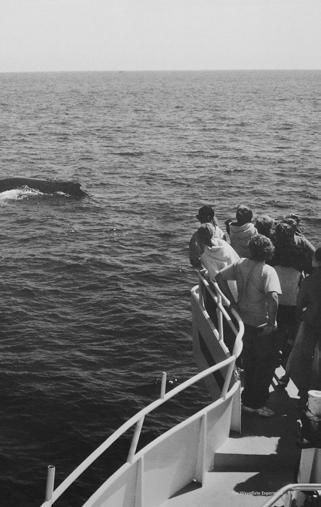
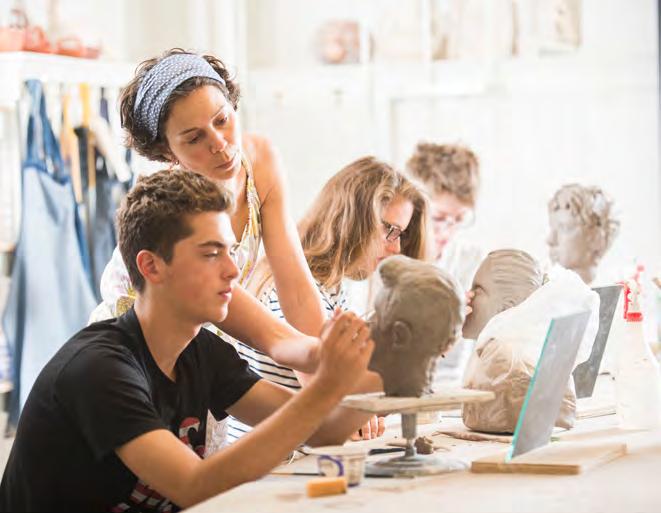

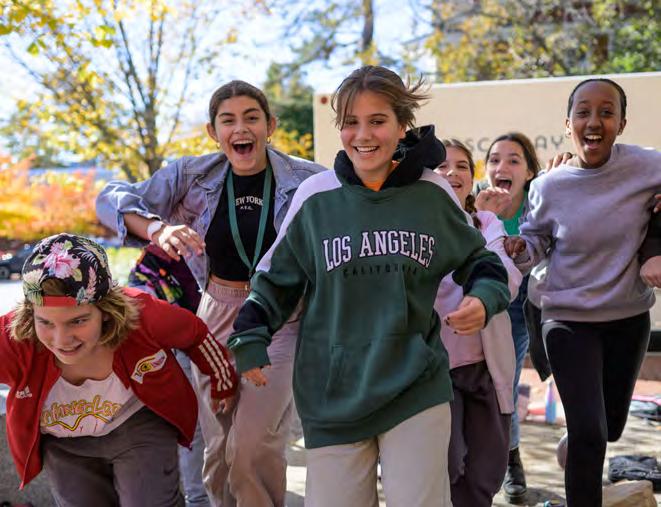
Students, faculty, and staff gathered on Waynhenge in late September to celebrate a special Convocation theme: “Telling Our Story: 125 Years of Waynflete.”
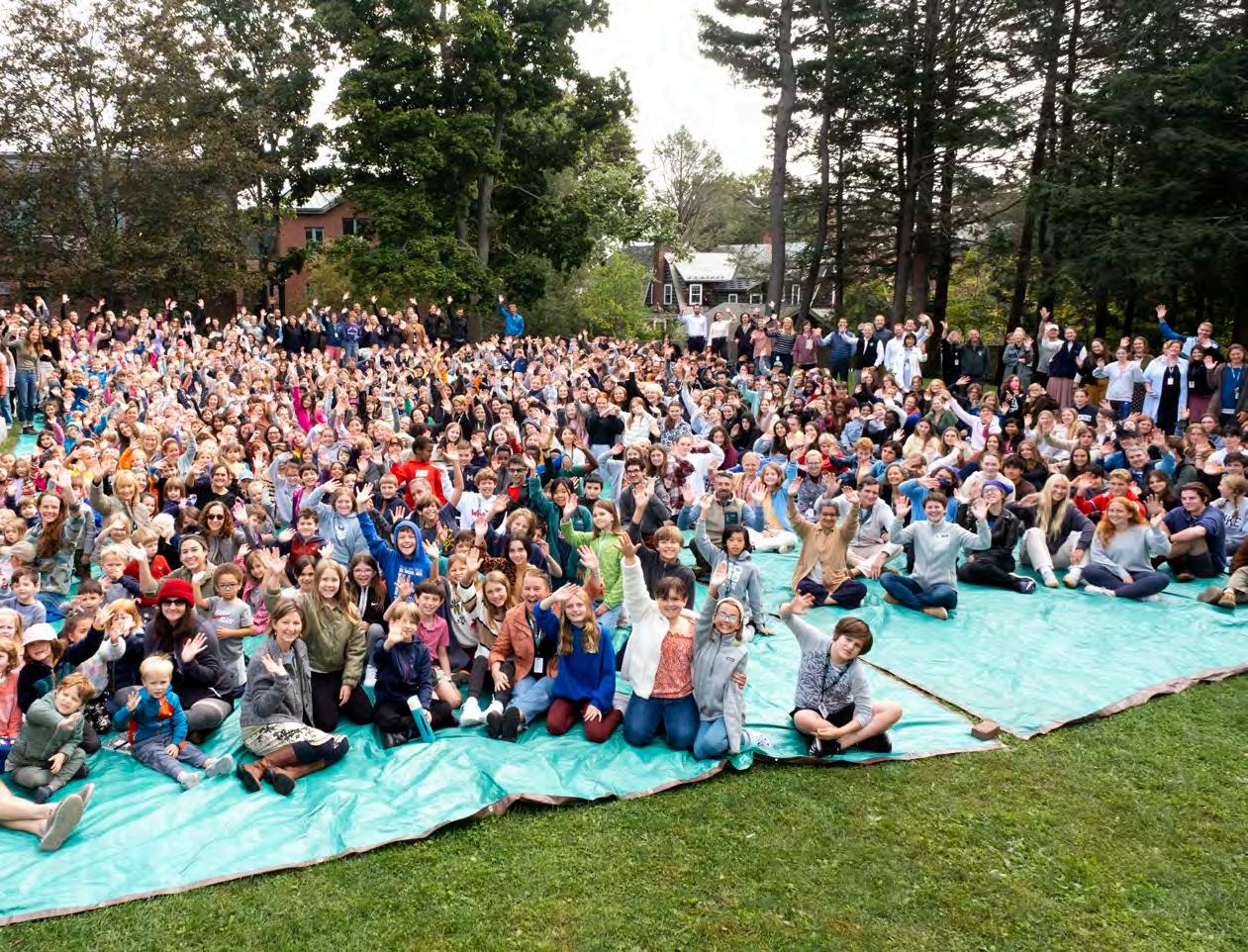
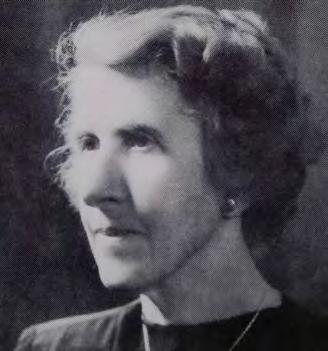
DESPITE THE establishment of a general endowment fund in 1937 and the Waynflete Alumnae Endowment Fund a year later, school resources remained thin. There were no tuition increases from 1933 to 1948. During the Depression’s height, faculty worked for half pay. Their morale was no doubt kept afloat by their principal’s example. Besides managing the school on a stringent budget, Barbara Woodruff taught all four high school English classes, directed a homeroom, and was housemother to twelve boarding students at the residence house on West Street. The community soldiered on even as the student body dwindled; there was no graduating class in 1937.
Barbara Woodruff’s leadership bridged the Great Depression and the Second World War. “ The Depression and I arrived at Waynflete together,” she wrote later. She continued:
To read of the Depression is a remote experience. To have lived it is intimate and unforgettable. It was a frightening period of extreme insecurity, deprivation, and desperation; many, from personal agony, succumbed. For the Waynflete faculty voluntarily to have reduced their salaries by half may sound noble, but in reality it was a move to help the school survive. The making of a school or of a faculty often turns on a moment of crisis. The Depression became for us an endeavor, a test, a trial for the life of Waynflete not only to carry on, but to progress
Barbara Woodruff Freeman served as Waynflete’s headmistress from 1931–1948.
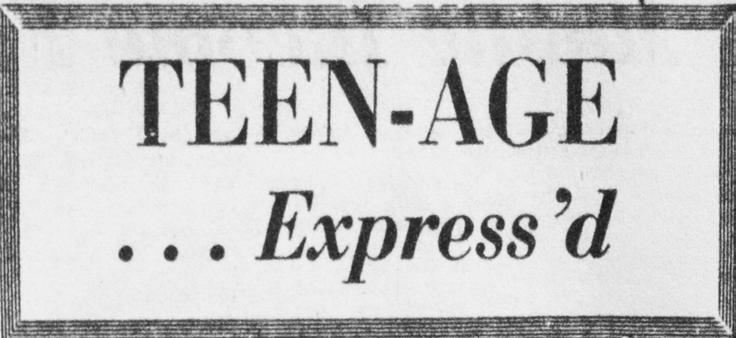
Portland had two newspapers in the early ’70s— the morning Press Herald and the Evening Express.
The latter featured a weekly two-page spread titled “Teen-Age...Express’d,” with articles from local high school reporters. Richard Bump ’71 contributed columns for Waynflete for two years. “The experience of seeing my byline in the paper of record almost every week was a great selfconfidence booster,” he recalls. “It was my first experience as a published writer, and writing has been part of my life ever since then.”



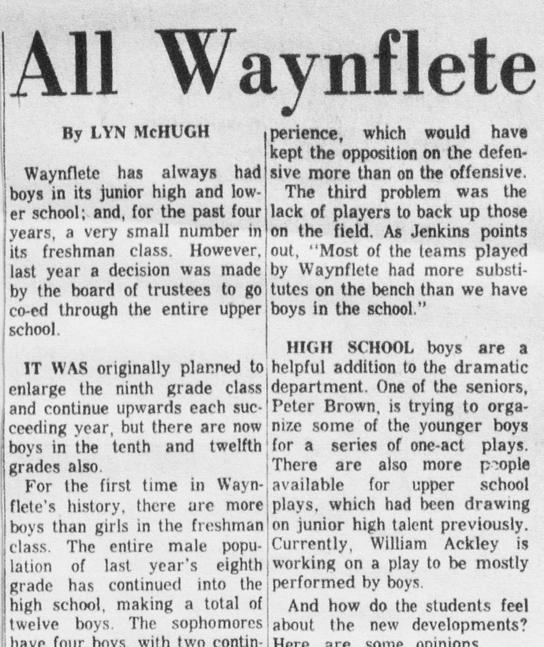

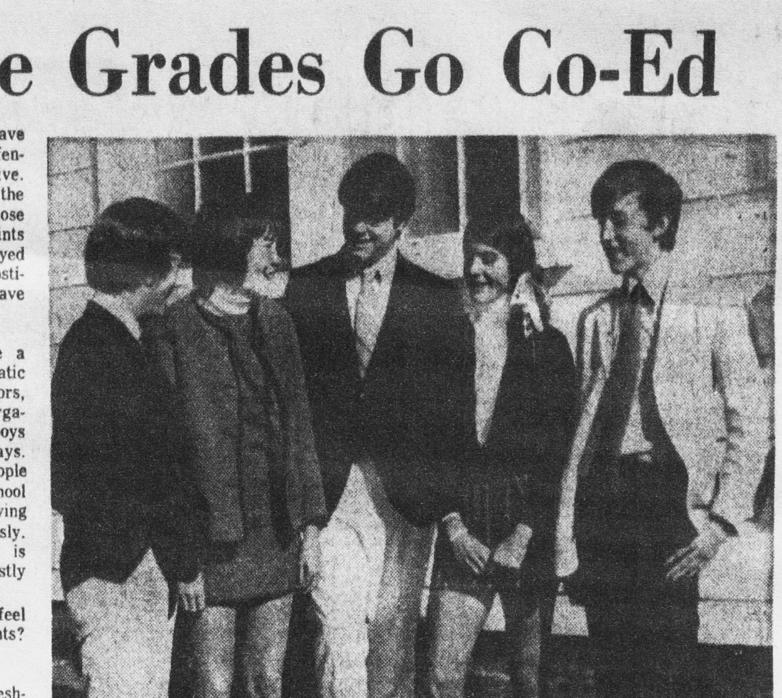
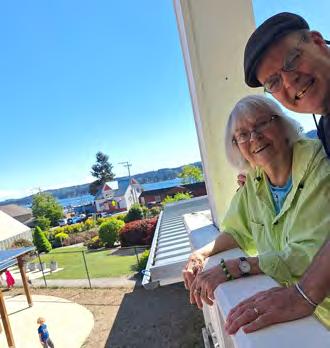
WE RECENTLY SPOKE with Waynflete’s oldest living alumna—Sally McAllaster, Class of 1945. Growing up in Cape Elizabeth, Sally’s high school years were dominated by the Second World War. Waynflete students participated in frequent fundraising drives during this time; they brought in quarters to purchase war bonds and collected waste paper to sell for the benefit of the Red Cross. Gas rationing necessitated a later start to the school day, as many students had to make their way to campus from surrounding towns by municipal bus.
Naval officers were billeted in a mansion on the site of current-day Waynhenge. (This building would later become Storer House, the home of Waynflete’s Lower School until it was destroyed by fire in 1987. The large pieces of granite in the Piney Woods are the remnants of this structure.) McAllaster recalled that these young officers served as convenient dance partners at a school that was girls only in older grades—all under the watchful eye of Headmistress Barbara Woodruff Freeman.
Sally matriculated to Bennington College, where she studied French. Today she lives near Seattle, Washington, almost 80 years after graduating from Waynflete.
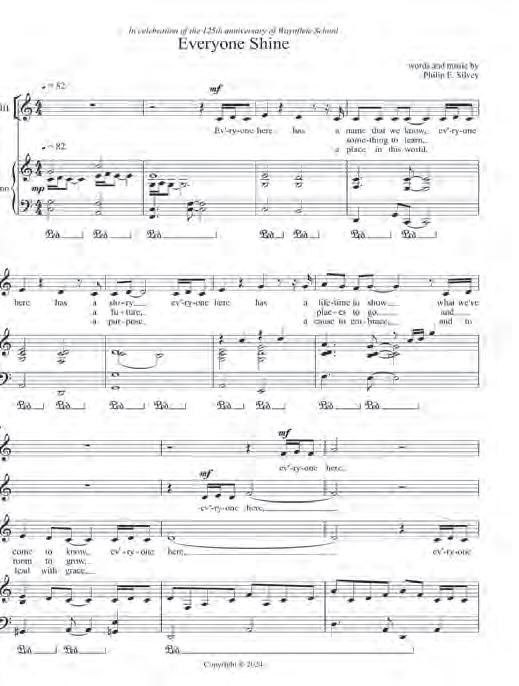
“Everyone here has a name that we know, Everyone here has a story ...”
IT IS CUSTOMARY for institutions to mark major milestones with a commissioned work of art. With that in mind, Director of Performing Arts
Mary Jane Pagenstecher reached out to friend, colleague, and acclaimed composer, Philip E. Silvey, to commission a new school song. The intention was to create a piece with flexible voicing to allow for a full choral arrangement to be performed by ensembles of varying ages and experiences, and to also be sung as a tune alone by singers of all ages, with a melody and lyrics designed to make it accessible and relevant for all.
The collaboration began in the summer of 2023 at the same time that efforts were ongoing as part of the strategic plan to create the Portrait of a Graduate. In numerous conversations, Mary Jane and Philip discussed the school’s mission, traditions, general ethos, and ideas captured in the emerging portrait. A skeletal draft of the song was received in January 2024, and the Waynflete Intergenerational Chorus (singers in grades 4–12 and faculty/staff) took it for a “test-drive” in rehearsal. From that first look, the song was essentially “Waynflete,” with the opening lyric, “Everyone here has a name that we know, everyone here has a story.”
Observations and suggestions from the chorus were shared with Philip in February and a fully realized final draft was delivered in March. Philip and Mary Jane continued to adapt the arrangement to match the intergenerational ensemble, and “Everyone Shine” had its spectacular world premiere in the Franklin Theater on May 2 as part of the Spring Choral Concert. “Everyone Shine” will be introduced to the entire Waynflete community at the annual Convocation in September 2024.
Watch the premiere of “Everyone Shine” at bit.ly/24mag-12.
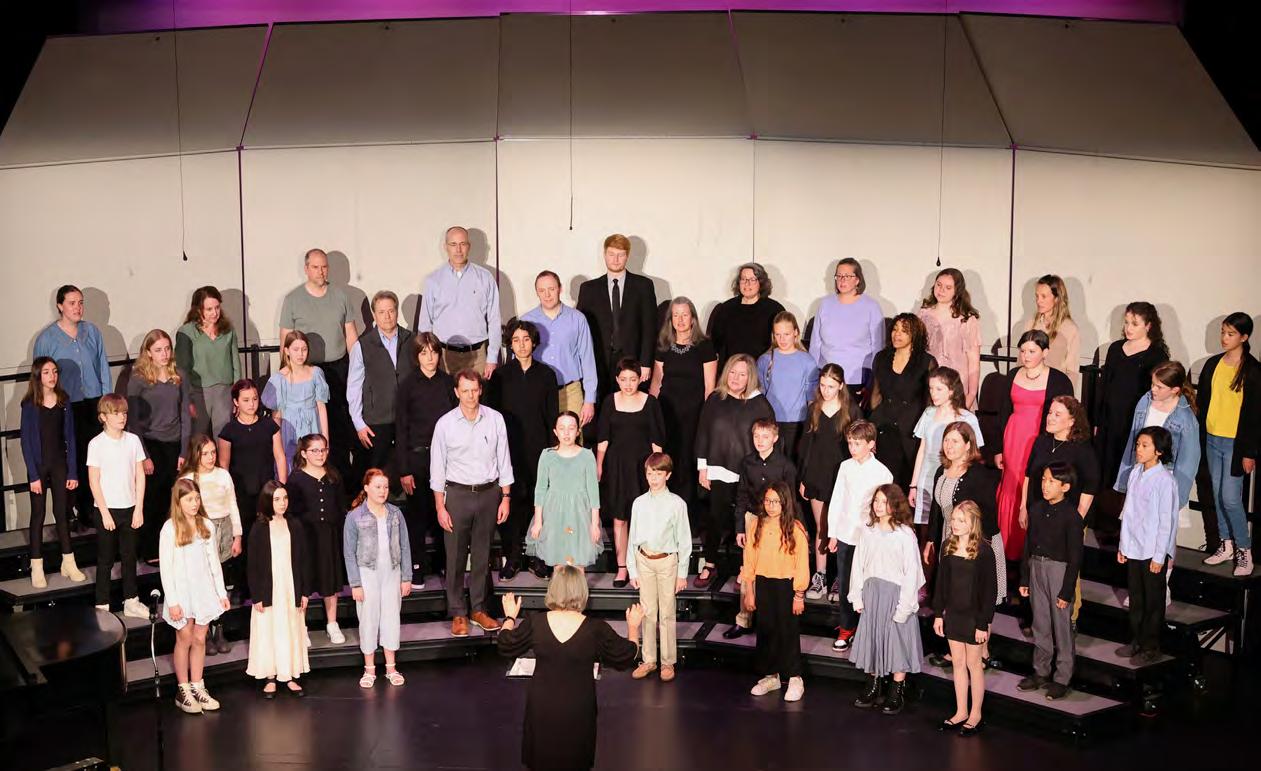
MEET WAYNE , Waynflete’s new mascot! Wayne is a wombat, as you may have already guessed—arriving just in time to celebrate our 125th anniversary and all done up in Flyers gear, with a bomber jacket, aviator cap, goggles, and a biplane-appropriate scarf. After making his debut at Friday Night Flyers Fest this spring (bit.ly/24mag-14), Wayne has been seen leading a conga line at Pachanga, hamming it up at Spring Fling, highfiving graduates at the Senior Clap-In, and dancing with Susan Nelson at the Honorary Alumni Ceremony and Reception!
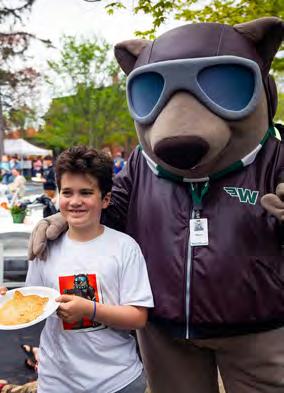


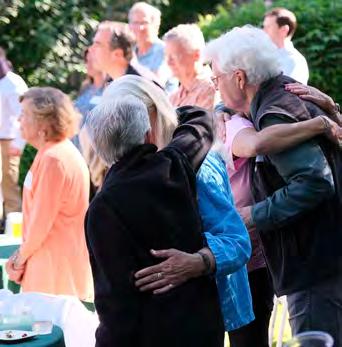
THE SUCCESS and longevity of Waynflete is inextricably linked to the exceptional individuals who have shaped our community over the years. From our visionary founders, Agnes Lowell and Caroline Crisfield, to the dedicated faculty and staff members who continue to inspire, guide, and connect with our students today, it is the people who have made Waynflete the extraordinary institution it is.
The Honorary Alumni program, appropriately unveiled during Waynflete’s 125th anniversary year, recognizes these special members of the Waynflete community. The program acknowledges the remarkable contributions of employees who have dedicated 15 or more years of service to the school by bestowing the title of “honorary alumna/us” on them. This honor is a testament to their unwavering commitment to Waynflete’s mission; the ways in which they have shaped the school’s history; and the lasting bonds they have forged with students, families, and colleagues.

More than 100 current and former Waynflete faculty and staff attended the inaugural Honorary Alumni Ceremony and Reception at Boulos House in early June. Friends and colleagues enjoyed a beautiful evening together, reminiscing and celebrating with delicious treats, warm embraces, and plenty of laughter.
WE ARE LEARNING TO LEARN SIDE BY SIDE, HAND IN HAND

Highlights of a
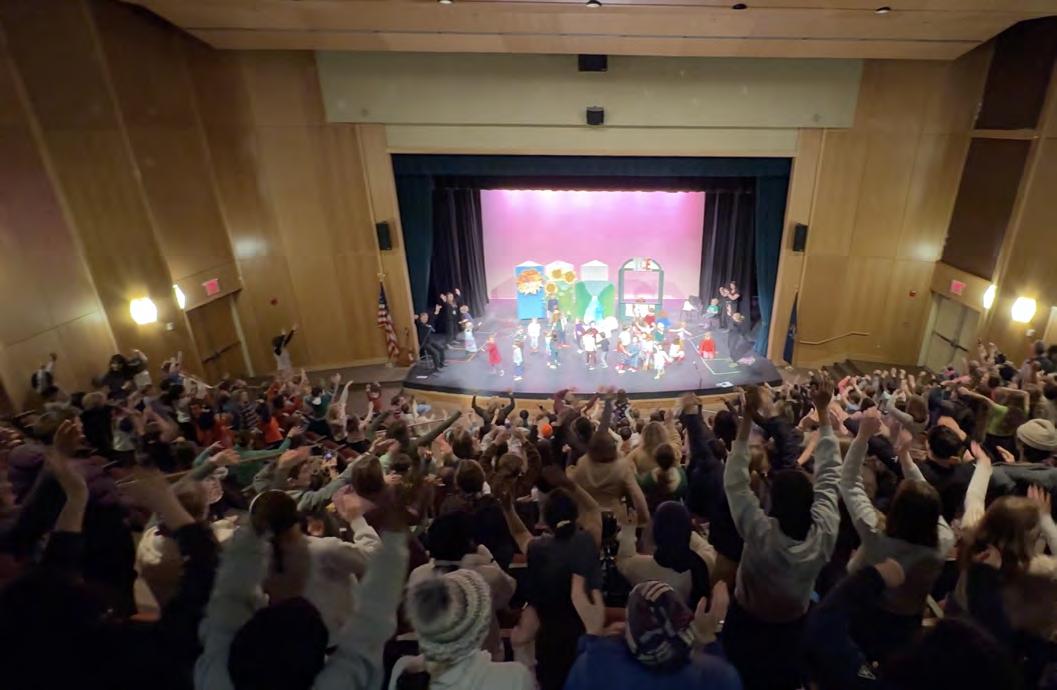
In the Lower School, every student has a buddy. Early Childhood students pair up with their friends in grades 2–3, while K–1 students match with their pals in grades 4–5. These multiage buddies spend the beginning of the school year learning more about each other, bonding through conversation, playing games, and reading together. They often sit as a pair at Pachanga and show up to support one another when it’s time to share projects with the class. Buddy time is often the highlight of the week for many Lower School students. Through these interactions, older students not only cultivate leadership and communication skills but also
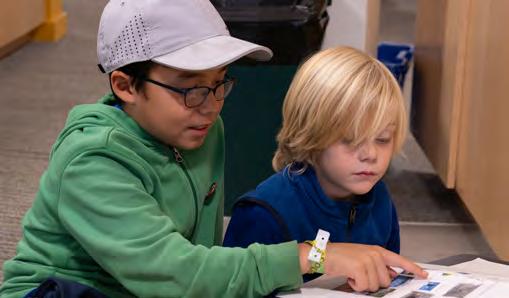
At the conclusion of this year’s Early Childhood play, Waynflete’s youngest learners led students from all three divisions in a spontaneous and joyous Miley Cyrus singalong! Watch the video at bit.ly/24mag-15
K–5 teachers recently completed the three-year process of integrating Illustrative Math (IM) into the curriculum, and with this change, the role of Lower School math coach has evolved. Anna Halat partners with faculty in all four programs, focusing on implementing the program, differentiating instruction, team teaching, and supporting computational fluency. Even our youngest learners benefit—Anna works with Early Childhood teachers to integrate IM practices and routines. Small classes and dedicated faculty mean that we’re able to differentiate classroom instruction based on different aptitudes and abilities.
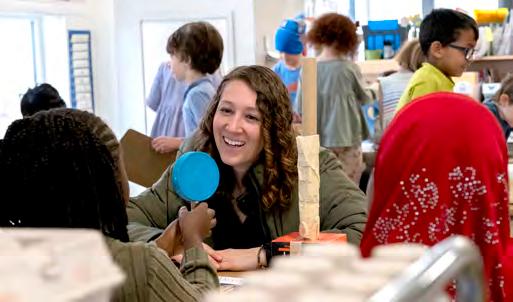
Eighteen Middle School students embarked on the second iteration of Waynflete’s Winter Ice and Snow Program (WISP) in New Hampshire’s White Mountains in March. Guided by experts like Stephanie Dolan and Dr. Susana Hancock ’03, the group explored the realms of snow science and climate change indicators. Their expedition spanned four days and included time spent in the high huts above the tree line. Despite the challenging weather conditions—a foot and a half of new snow and peak wind gusts hitting 100 mph—students remained undeterred and were thrilled by the hands-on learning experience. Learn more about WISP at bit.ly/24mag-13.

Working collaboratively in small groups, grade 7 students constructed large sculptures depicting threatened Maine animals as part of their thematic exploration of “home.” This assignment underscored the importance of environmental awareness, as students share their home—the state of Maine—with these animals. Students conducted research on each animal, learning about their characteristics, their habitats, and the challenges they encounter. Using chicken wire, they created armatures, which they covered with layers of papier-mâché before painting the final surface. By showcasing their sculptures, the students hope to inspire curiosity and appreciation for these vulnerable animals and to call attention to the need to protect the natural habitats living creatures call home.

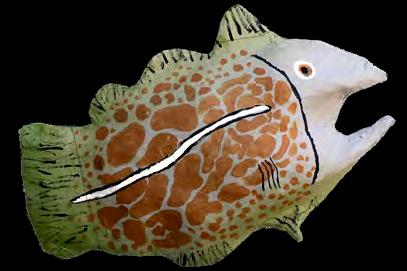

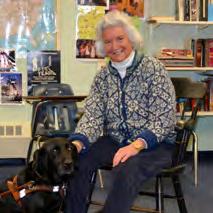
The Debba Curtis Cup in Rhetoric is presented in honor of longtime Waynflete history teacher and debate coach Debba Curtis. Each year, the cup goes to a student who displays extraordinary dedication, insight, and creativity during the ninth-grade debates, collaborating thoughtfully with their teammates, arguing their position with passion, demonstrating broad knowledge and keen mental agility, and owning the podium. We applaud the winner for their contributions to the intellectual life and community of Waynflete. This year’s recipient was Athena Esbjörn-Hargens, who stood out for her deep knowledge of her topic, her willingness to speak with authority, and her quick, fluent responses to the opposing argument.
One of the most exciting aspects of the new academic year in Upper School is the introduction of new electives. Popular offerings this year include Political Ideologies, The Making of the American Criminal, and Cybersecurity. Head of School Geoff Wagg and former Upper School Director Lowell Libby have teamed up to teach Is American Democracy on Fire? on the Malone Schools Online Network (MSON). Learn more about MSON at bit.ly/24mag-19.
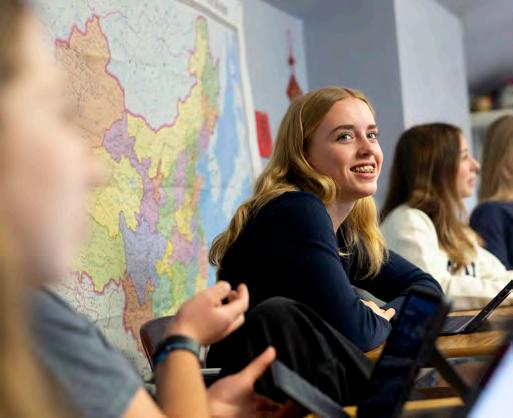
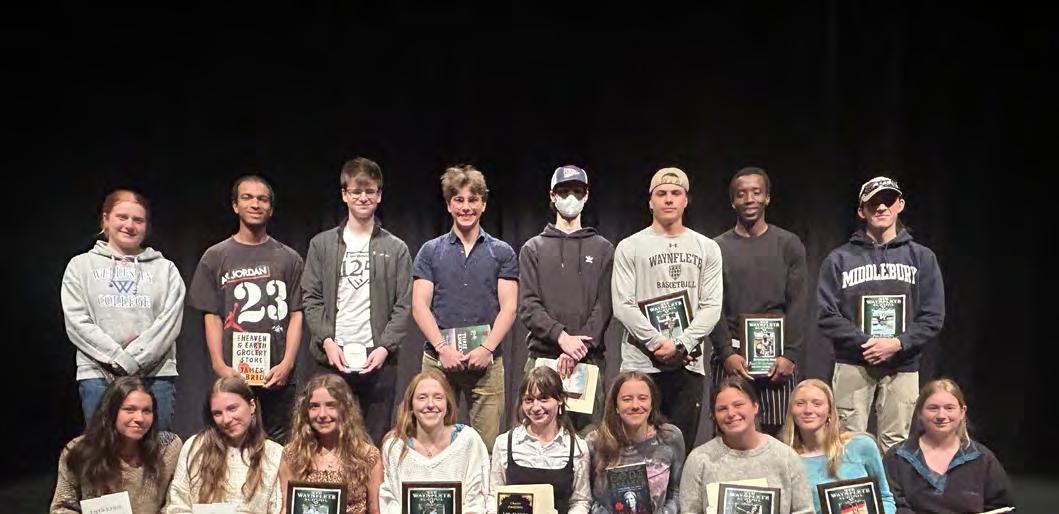
Every year, Upper School faculty and students gather for a special assembly to recognize outstanding achievements and contributions to the school. Waynflete’s Upper School awards celebrate those individuals who have demonstrated an exceptional commitment to their academic pursuits, extracurricular activities, and service to others. Learn about this year’s honorees at bit.ly/24mag-17.
Faculty from all divisions participated in a professional development opportunity brought to Waynflete by a team of educators from the University of Southern Maine. The event focused on the work of American sociologist, historian, and civil rights activist W.E.B. Du Bois and Black history as they relate to our current understanding of diversity in Maine.
The active learning experience included a gallery walk showcasing copies of over 40 data visualization posters that were first presented at the Paris Exposition Universelle in 1900, brief presentations with data about Maine’s diversity and immigrant populations, facilitated small-group discussions, and moments of reflection. This symposium was a powerful experience for many, and the lessons and ideas gleaned from this experience will inform teaching in years to come.

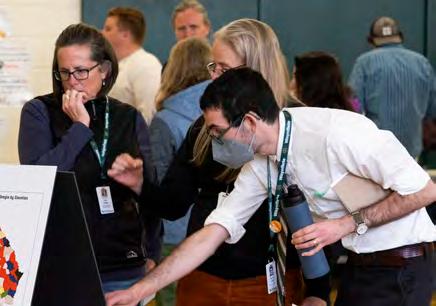
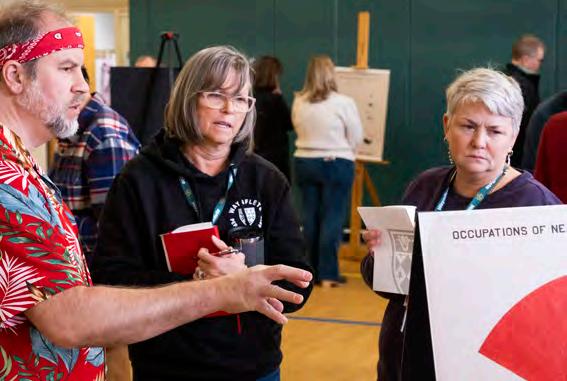

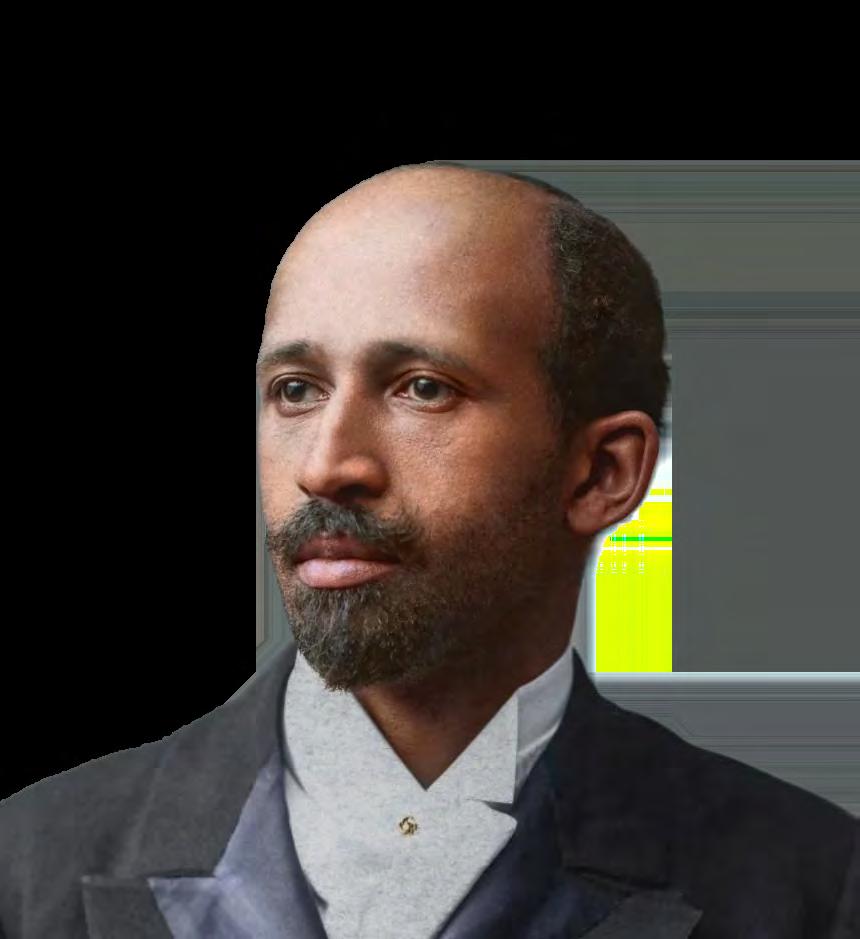
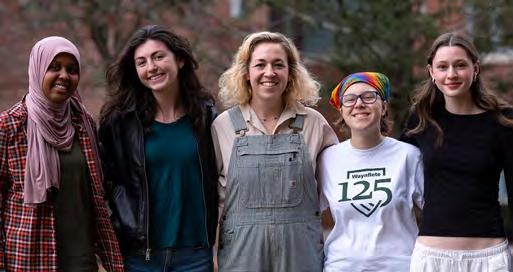
LAST FALL, Waynflete offered a digital journalism course taught by local podcast producer and journalist Emma Reynolds. During the semester, students produced podcasts and wrote articles about stories in the Waynflete community. They learned how to conduct interviews, record audio, and edit. At the end of the semester, the students created a website that features all their work.
Upper School Director Asra Ahmed had two objectives in mind when she created this course: to begin the process of creating a dedicated journalism program at Waynflete, and to provide an additional educational experience that is interdisciplinary, intellectually rigorous, fun, and driven by the students who choose to participate in it.
“I know from past experience that student-run journalism is an important way for students to take ownership of their school community, to help them reflect on their school experience, and to take responsibility for supporting the school in its constant evolution. Journalism programs also provide students with significant life and educational skills, like writing, research, interviewing, and interpersonal skills. They have to learn about history, politics, the Constitution—for example, what is freedom of speech?—and they have to incorporate that knowledge into their journalistic works.”
Journalism programs help students see that leadership skills manifest in a variety of ways, including being a journalistic voice for one’s community. Asra points out that these programs push students to see their whole community instead of just the segment of it that they are drawn or attached to.
“The digital aspect of it is something I chose to focus on because it is aligned with where journalism is currently,” says Asra. “Students craft written pieces, but they also learn about podcasting as another means of sharing news and culture with their community and see how it can provoke conversations about topics that could be overlooked.”
1. John Calvin Stevens, collections of the Maine Historical Society
2. 163 Danforth Street, photo after 1903, Waynflete archives, courtesy Paul S. Stevens
3. 65 State Street, 1901, Waynflete archives
4. Inset: Spring Street entrance, before 1890, collections of the Maine Historical Society; Danforth Street entrance, c. 1900, collections of the Maine Historical Society
5. Daveis Hall, Lower Field
6. Morrill House, LEFT: 1924, Collections of the City of Portland, Planning and Development; RIGHT: Garage, 1924, Collections of the City of Portland, Planning and Development
7. Ruth Cook Hyde House, 1924, Collections of the City of Portland, Planning and Development
8. Hurd House, 1924, Collections of the City of Portland, Planning and Development
9. Emery Building, c. 1900, Collections of the Maine Historical Society
10. Founders Hall, 1924, Collections of the City of Portland, Planning and Development
11. T homas House, 1924, Collections of the City of Portland, Planning and Development
12. Boulos House, c. 1924, collections of the Maine Historical Society
13. Gymnasium, 1974, Waynflete archives
We were thrilled to connect with the Waynflete community over the past year!
In October 2023, students came together for the all-school pep rally, featuring cheers from all divisions and an exciting freestyle soccer performance from Waynflete alum and current US freestyle champion Patrick Shaw ’21. Later that day, the girls varsity soccer team secured an impressive 9–1 victory over Sacopee Valley at the first-ever Friday Night Lights game. More than 500 people came out to enjoy treats, get their faces painted, and cheer on the Flyers under the field lights. After the game, Upper School students danced the night away at the first-ever Homecoming/Spirit Dance. Watch a video of the pep rally at bit.ly/24mag-3.
The second annual Community Celebration in early February was a resounding success. Waynflete families and friends enjoyed performances in Franklin Theater from Maine-based Brazilian storyteller Antonio Rocha, Maine-based American Roots trio Darlin’ Corey, and Benkadi Drum and Dance, a group of artists and educators dedicated to performing, teaching, and researching African dance and musical forms. The program was followed by a potluck dinner that featured delicious food from many different cultures. Watch the performances now at bit.ly/24mag-4.
In early April 2024, the Waynflete community gathered for an eclipse-viewing party on the Western Prom. Families and friends donned their special eclipse-viewing glasses and spent the afternoon enjoying moon pies and other treats together during this once-in-a-lifetime astronomical event. Watch a time-lapse video from the afternoon at bit.ly/24mag-5.
This year’s Grandparents and Friends Day celebrations started with an evening reception on May 2 at Head of School Geoff Wagg’s home, followed by a special program at the school the next day. Guests were able to enjoy breakfast and a 125thanniversary presentation together before experiencing classes with their students and exploring Waynflete’s Spring Street campus. Check out the photo gallery from the event at bit.ly/24mag-6 and the reception at bit.ly/24mag-7.
Families, alumni, faculty, staff, and other Waynflete community members gathered for another special evening at Friday Night Flyers Fest on May 10—and made a new friend! Our new mascot, Wayne, made his debut in between games and spent some time getting to know our community. (Wayne’s a wombat, all done up in Flyers gear.)
After the games, our Middle School students enjoyed their last social of the year—a great ending to this incredible night! Haven’t met Wayne yet? Watch a video of him meeting his new friends at bit.ly/24mag-8.
One week later, the Waynflete community gathered again for Spring Fling, the Parents Association’s biggest fundraiser of the year. Hundreds of parents, guardians, staff, faculty, students, and friends came to the Spring Street campus to create, play, and celebrate the bonds we share. It was an incredible day of connection, made possible by the tireless efforts of the Parents Association, countless volunteers, and many sponsors and local businesses. Check out the photos from this exciting day at bit.ly/24mag-9.
Members of classes ending in 4 and 9 joined current and former faculty, staff, and other community members on campus to celebrate their milestone reunion years during Reunion Weekend. The enthusiasm was palpable as we enjoyed moments of connection through a number of special events, including the 50th Reunion Brunch, Waynflete Service Awards presentation, Athletic Hall of Fame induction ceremony, and the All Alumni and Reunion Reception. It was a pleasure to celebrate the relationships within the Waynflete community! See photos at bit.ly/24mag-10.
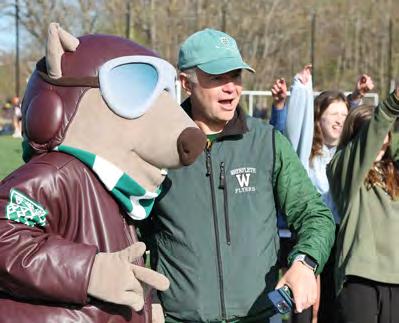
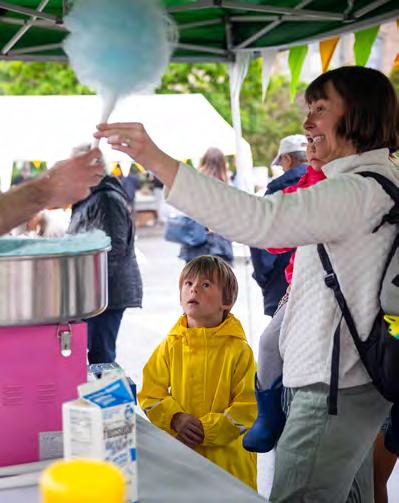


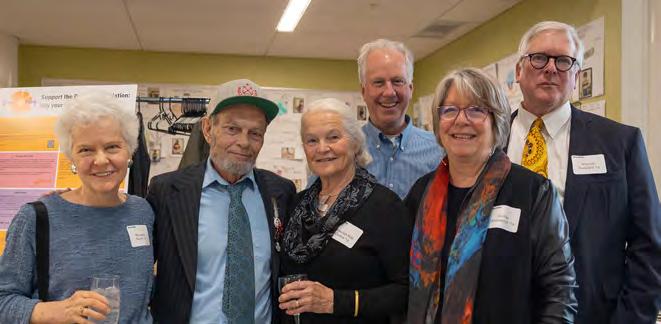
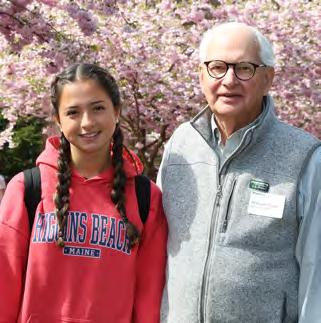



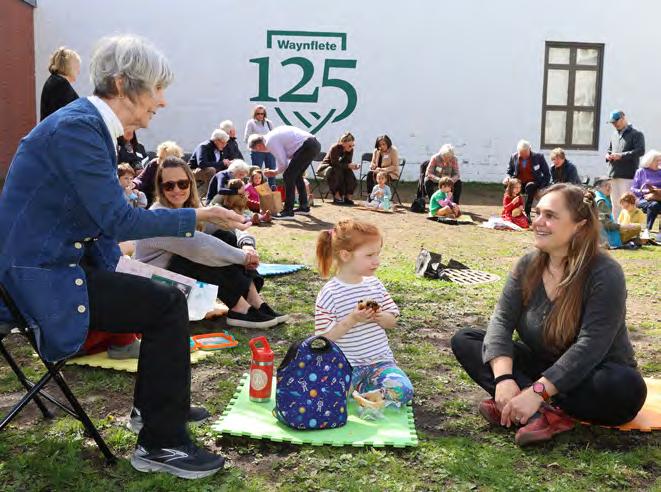
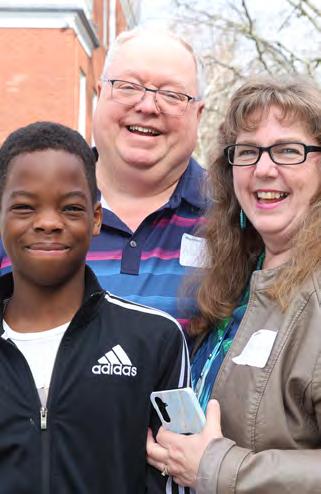
Waynflete’s Athletic Hall of Fame was established in 2022 to recognize those athletes, coaches, administrators, supporters, and teams who excelled in their respective sports or coaching/support roles and who brought honor to the school. The school is pleased to announce the Athletic Hall of Fame Class of 2024. The Hall of Fame selection committee has chosen four individuals to receive this special honor:
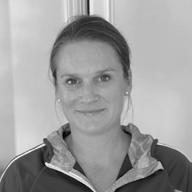
Amanda Waterhouse
Isgro ’98, Athlete
Amanda had an impressive career as a Flyer. As a soccer player, she led the Flyers to state championships in 1995, 1996, and 1997. She was named the Maine Gatorade Soccer Player of the Year in 1997 and also won Maine Sunday Telegram Soccer Player of the Year. On the lacrosse field, Amanda led her teams to state championships in 1997 and 1998 and was the leading scorer. She also found time to compete as an equestrian in many horse shows around New England, often finishing in the top three. Amanda attended Bates College, where she played soccer for four years. She scored four goals while leading Bates to the ECAC finals in 2000 and was named Bates Athlete of the Week during the 2001 season. Today, Amanda continues her passion for soccer as a varsity soccer coach for Temple Academy and is president of the Waterville Youth Soccer Association.
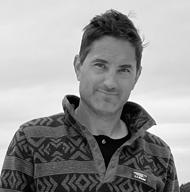
Matt Marston ’97, Athlete
Matt was a standout cross-country runner and lacrosse player for Waynflete. In 1996, he became the first Flyer to win an individual crosscountry state championship. He also led the team to its first state title. Matt served as co-captain of the 1997 boys lacrosse team, which won Waynflete’s first boys lacrosse state title, and was named to the all-state team for lacrosse defense. He was a co-founder of the school’s Nordic ski team. Matt was chosen as Waynflete’s male athlete of the year in 1997 and competed in cross-country and lacrosse at St. Michael’s College. He is the owner of Basics Fitness and continues to support Waynflete as a parent of two student-athletes.
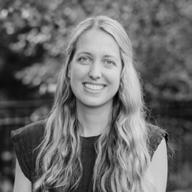
Christine Ordway Opperman ’09, Athlete
Christine was a standout tennis player for the Flyers. She was a three-year team captain and state player of the year three times. She also won the state singles title in 2006, 2007, and 2009. Christine won a team title in 2006 and went on to win the New England Tennis singles title that same year. She attended Division 1 Cornell University, playing #1 and #2 singles and serving as team captain for two years. Christine continues to share her love for tennis as a middle school tennis coach at Alexandria Country Day School, where she is a learning specialist.

Brandon Salway, Former Assistant Athletic Director and Physical Education Teacher
Brandon served on the athletics and physical education programs at Waynflete for 34 years. He guided the boys soccer program to eight state championships and also led the 2013 girls basketball team to a state championship. Brandon was a beloved PE teacher who taught sports skills and movement for more than three decades while developing students’ sportsmanship and their love of the game. As the assistant director of athletics, he supported all aspects of the program and mentored many young coaches. Brandon entered the Waynflete Athletic Hall of Fame in 2023 as coach of the 1993 boys soccer team. He is being honored individually in 2024 for his long record of outstanding service and success.
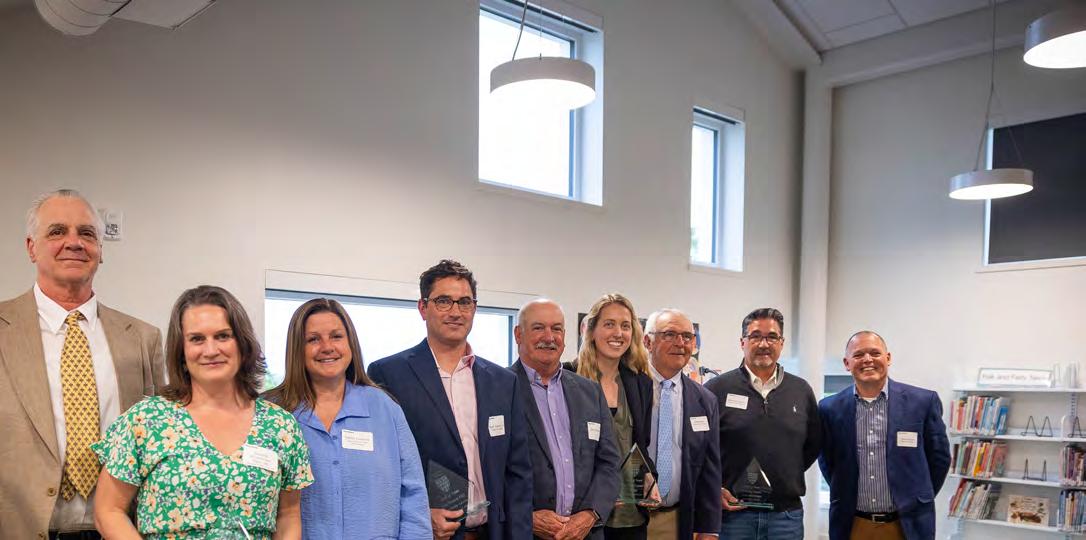
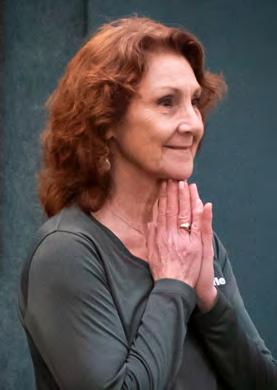
After an incredible 49-year run at Waynflete, Susan Charles Nelson completed her teaching career in June. Her legacy is immense and aweinspiring. Susan hopes to travel and spend more time with her family in her retirement. She has been a proud parent and grandparent to several Waynflete students.
Over the past four years, Susan has focused her tireless efforts on the Lower School. She developed a creative movement curriculum for every program including EC, and she taught every Lower School student! Those lucky students explored storytelling through movement and deepened their understanding of curricular strands as Susan incorporated thematic studies. Susan’s students have shared their work at Pachanga, during Lower School May Day, and in countless concerts. Enrichment classes (for dancers in grades K–8) and her Middle and Upper School Danceflete Collective program have given hundreds of students a chance to be expressive on the big Franklin Theater stage. Susan has always been a champion of student choreography and gave her dancers every opportunity to develop their unique creative voices. We wish Susan the very best as she leaps into this next stage.
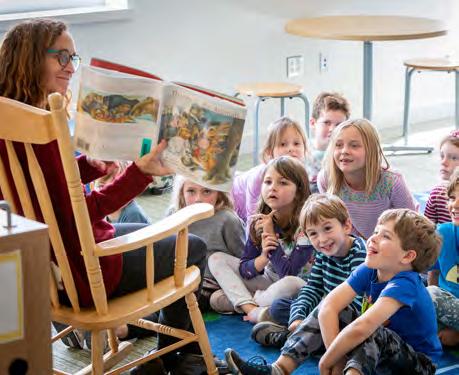
After many years of dedicated service, Laurel Daly has turned the final page of her time as a librarian here at Waynflete.
Laurel joined the Waynflete faculty in September 1999 and is mom to two Waynflete alumnae, Nora ’14 and Hannah ’11. In her 25 years here, Laurel has taught thousands of youngsters how to find books and other resources that satisfy their curiosity, open their hearts and minds, and connect them to our shared human experiences. Since the Klingenstein Library’s opening in fall 2018, Laurel has curated the space for the school’s Lower School collection, book projects, art sharings, board meetings, and the program’s library classes. Laurel has always been willing to step up to fill a need in the school community—whether it’s a book, a supportive ear, an advocate, or a recess duty. As a result, she has touched thousands of lives in our school community. Laurel and her partner retired at the end of the school year to begin the next chapter of their lives together. Join us in thanking her for her incredible service to our school.


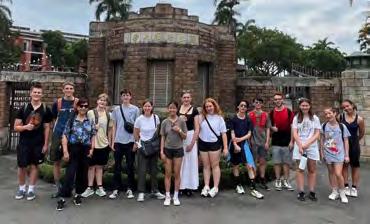

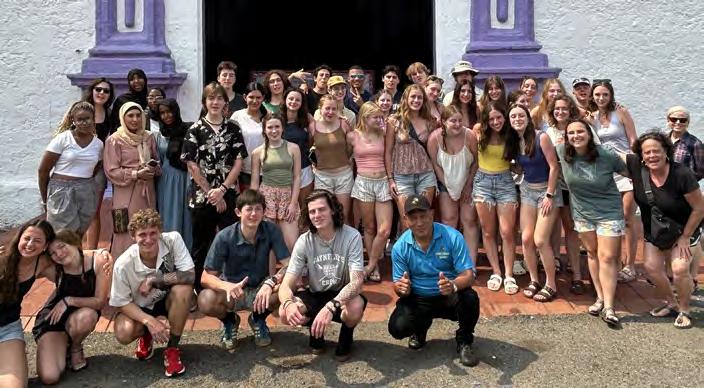
The Upper School Spanish trip to Panama was an adventure! We explored from the Pacific to the Atlantic coasts and along the Panama Canal, engaged in intercultural exchange, explored the rich biodiversity of the rainforest and the Caribbean reef, and immersed ourselves in the history of Panama from past to present. Highlights included riding in motorized, handbuilt Emberá canoes, dancing and fútbol matches with locals, shopping, meal planning and interviewing vendors in a Panama City market, day hikes exploring the rainforest and the plethora of species that inhabit them, snorkeling in a Caribbean reef with biologists working to revive it, and learning about the economic importance of the Panama Canal. We communicated often in Spanish with our well-loved local guide, Gabo. Students were wide open to new experiences at every turn, and they traveled with wonder and open hearts.
¡“Bia bua” a todos! —Janice Ribeiro
Thirteen Chinese language students traveled to Taiwan in mid-June for a 12-day educational sightseeing and school-exchange program. Splitting their time between Taipei and Yilan, in eastern Taiwan, our students gained insights into the country’s history, traditions, architecture, and culture while improving their Chinese language skills with activities like language-based scavenger hunts in local night markets and neighborhoods. Students had the unique opportunity to stay with local families for part of the trip and attend school at the Shoushan High School with their host siblings. It was a wonderful opportunity to put our classroom lessons to use!
Heather Courtice Hart ’88
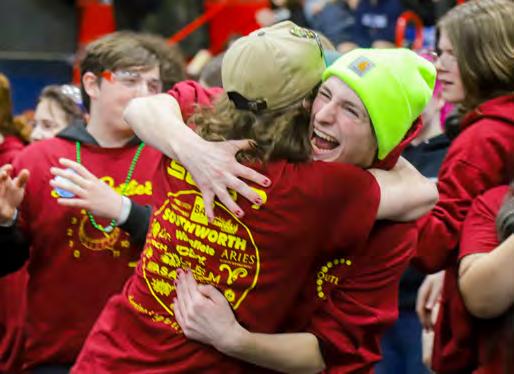
The Outliers Robotics team kicked off a fantastic season by winning the Granite State Robotics competition, beating out 35 teams from across New England in this three-day event in New Hampshire. Despite grappling with unexpected and complex mechanical, electrical, and coding problems throughout the competition, the Outliers pulled together and worked through the night to deliver a skillful performance. They then moved onto the Pine Tree District event, where they teamed up with Buck’s Wrath, a team from Bucksport, and Rainbow Junkyard, a rookie team from Kennebunk, and went undefeated throughout the playoffs.
The Outliers continued to impress in the New England Championships, where they faced off against the region’s 96 top teams. They got off to a rocky start on the first day, as their robot was plagued with problems, but the team pulled together again and systematically worked through each problem—by the end of the second day, the team’s entry was statistically one of the top robots in the world! On the third day, the Outliers and their alliance sailed through the playoffs, winning every match until the finals. While they easily won the first match of the finals, they unfortunately lost the next two by narrow margins. In addition to coming in second place, the Outliers also won the Autonomous Award for their vision system, controls, and one-of-a-kind shifting gearboxes.
The Outliers capped off their tremendous season in April when they joined more than 60,000 students at the FIRST World Robotics Championship in Houston. The Outliers posted this year’s world high score in qualification matches and placed in the top 1 percent of teams worldwide. They also secured numerous accolades throughout the season, including the Autonomous, Excellence in Engineering, and Creativity awards. The team banded together to overcome adversity throughout the year and also built strong bonds with fellow competitors.
Jon Amory ’97
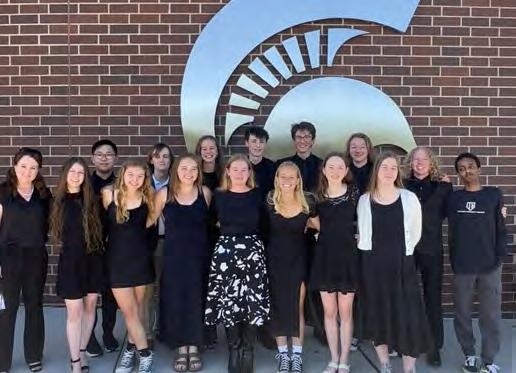
Fifteen Upper School science students traveled to MIT in January for an invitational Science Olympiad tournament. Students competed with schools from across the country in 23 different science and engineering events. Some events required students to design, build, and troubleshoot an engineering problem, while some were tests of knowledge in fields such as astronomy, microbiology, and forensic science, or field tests such as tree and fossil identification. Waynflete was the top team out of the four Maine schools present, and the Flyers did well against New England schools in general, placing fifth out of 23 New England schools. Waynflete placed 49th out of 72 teams overall and earned five finishes in the top half of the field.
Waynflete continued its reign as Maine State Science Olympiad champions in a close 23-event competition at the University of Maine in early April. The team beat Falmouth by a mere three points, illustrating just how important it is to perform at a high level in every event (and how well our competitors responded to the pressure!). This victory secured their place in the National Science Olympiad tournament at Michigan State University in late May, where they continued to perform well against teams from across the country. —Wendy Curtis


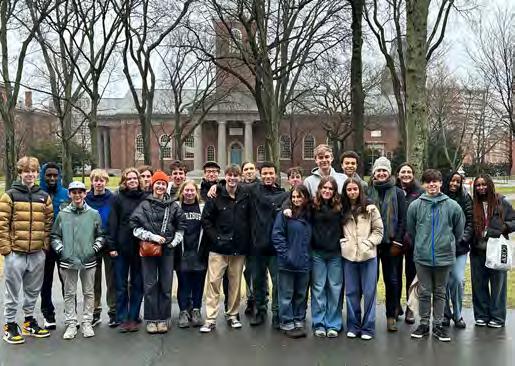
In the 2023-24 school year, the Speech, Debate, and Model UN team had lots of adventures and success. We participated in five parliamentary debate tournaments, four public speaking tournaments, a Lincoln Douglas and public forum tournament, and three Model UN tournaments. We traveled around New England, and all the way to British Columbia, to hone our rhetorical skills and discuss and debate important issues such as soil health, property rights on the moon, disarmament, decolonization, women’s reproductive health, and the Cold War competition for nuclear and space supremacy. We received many accolades, such as best small delegation at a Model UN tournament, multiple best and distinguished delegate awards, and a first place persuasive speaking trophy at an international independent school public speaking competition. This is just the third year of the current incarnation of the program. —Sarah Getchell
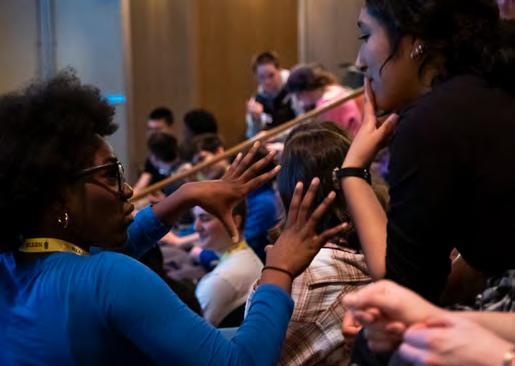
Third Thought Initiatives for Civic Engagement is a collection of programs that enable high school students from across Maine and New England to gather and reflect on their own identities and experiences while also learning from the perspectives of others. Third Thought is fortunate to have Waynflete as its fiscal sponsor, which fulfills critical space and administrative needs. Third Thought annually relies on philanthropic support and sponsorships from individuals, corporations, and organizations, however, to cover staffing, travel, and programmatic expenses. The Can We? Project provides opportunities for students to learn and practice the skills of dialogue across political and other differences. During the 2023–24 academic year, we worked with close to 300 students in 14 schools across Maine.
Unum Insurance awarded Third Thought a $50,000 Inclusive Impact grant to support the program over a two-year period. Can We? Connect welcomed all Can We? student participants to the Augusta Civic Center for a day of student-led dialogue on personal freedom, liberty, and topics of importance to high school youth. Can We? Connect was featured in a Maine Public radio broadcast (visit bit.ly/24mag-18 to listen to the segment).
The Maine Humanities Council awarded Third Thought a major grant to support Can We? Connect in the 2024-25 school year. The New England Youth Identity Summit welcomed 300 students from across New England for a day of youth-led workshops, keynote speakers, and professional and student performers.
The Perspective Project continued to work toward their goal of using the power of conversation to learn from and celebrate the perspectives, expertise, and experiences of members of our local and global community. This year’s guest speakers included artists, athletes, entrepreneurs, attorneys, and philanthropists.
John Holdridge
The Upper School Community Engagement Program (CEP) is grounded in Waynflete’s mission and is designed to “encourage our students’ responsible and caring participation in the world” and to “provide a range of experience and depth of inquiry” in ways that aid in the development and exploration of students’ identities as citizens and global community members. In an effort to support and further this work, the Community Engagement Fellows were established in 2023 to create space for student agency and vision-setting within the CEP. Each year, a small number of students are selected from a pool of applicants to help lead, support, and shape the program for their peers.
In their role, Waynflete’s Community Engagement Fellows have the opportunity to engage in responsible and ethical community engagement efforts, learn how to lead through the lens of equity and inclusion, understand the broader context of community engagement, and forge relationships across the Lower, Middle, and Upper Schools as well as with organizations in the greater Portland community. The Community Engagement Fellows program promotes on-campus leadership opportunities and helps students develop their skills as community leaders while cultivating a culture of ethical, responsible, and sustainable citizenship and engagement among their peers in the Upper School. Ultimately, the goal of the Community Engagement Fellows program is to create meaningful and authentic opportunities for citizenship and engagement that help instill in all our students the awareness of their individual and collective ability for change-making and to inspire a sense of responsibility to make a positive impact on the world around them.
Mesa Robinov ’13

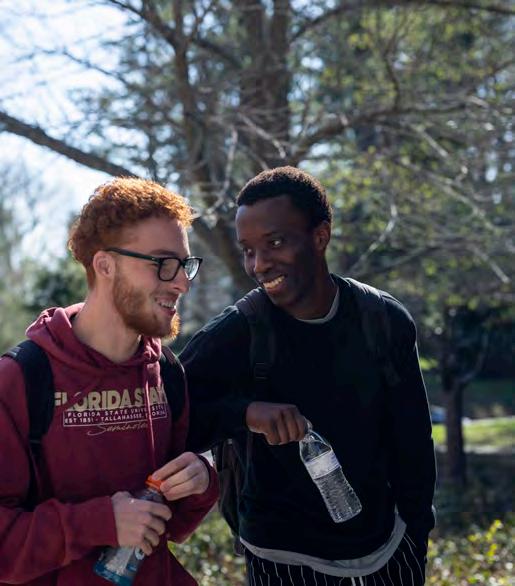




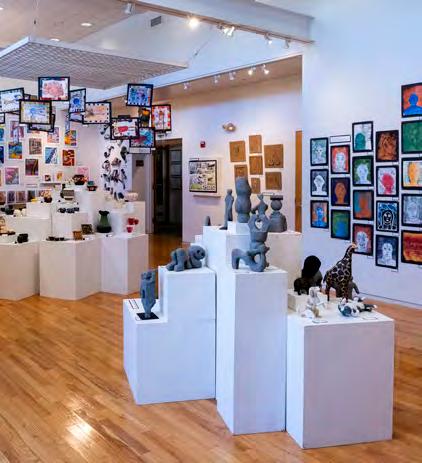






Student artwork, clockwise from top left: advanced studio, a view of the Waynflete Gallery during the All School Art Show, ceramics, Upper School paintings, match sculpture, photos of expressive eyewear, and sculptured floral stone figure.

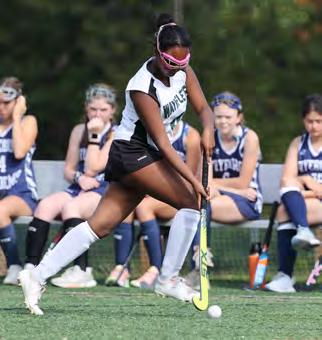
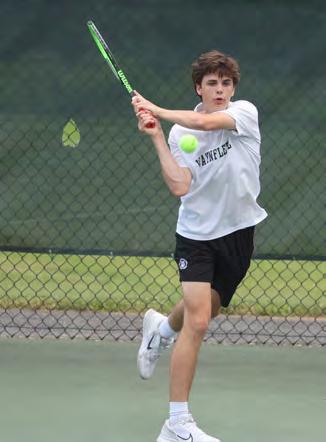
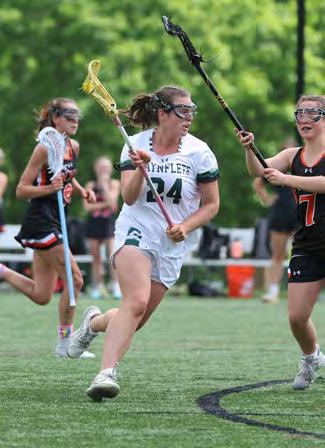
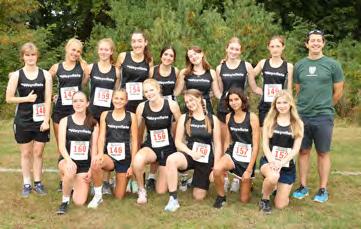

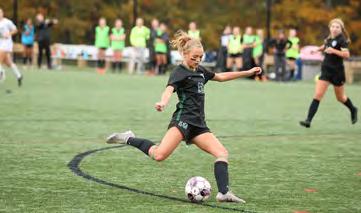
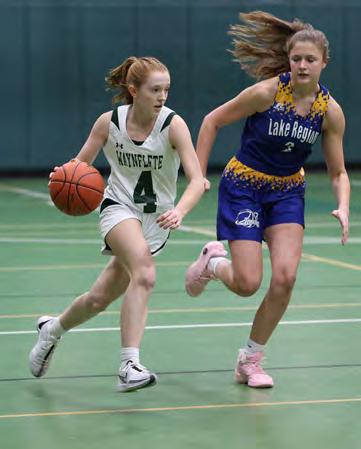
Girls cross-country had an excellent season, repeating as the Class C Southern Maine champions and finishing second in the Class C State championship, their best finish since 2014.
Girls soccer earned the Class C State championship for the first time since 2013. It was a nail-biter: 0–0 after two overtimes, then tied 3–3 after the first round of penalty kicks. Waynflete won 4–1 against Fort Kent in the second round of penalty kicks.
After many seasons of co-op teams and a yearlong hiatus, the Flyers varsity field hockey team returned to the pitch! New head coach Rowena Schenck led the team to five wins and a spot in the playoffs, where they unfortunately fell to #1 seed Spruce Mountain.
Girls basketball made a magical run to the Class D South regional finals this year. They defeated Islesboro in the quarterfinals and Forest Hills in the semifinals, before ultimately losing to Valley in the Southern Maine championship. They finished with a final record of 15–6.
Girls Nordic skiing secured second place in the Class C State championship, with impressive performances from Leah Kramer ’25, Nyssa Wilkinson ’26, Naomi Rice ’27, and Cecily Niese ’25.
The girls varsity lacrosse team won the Class C divisional championship over Traip Academy 18–6 before securing the state championship with a sensational 14–7 victory over Wells.
The girls varsity tennis team defeated the Maranacook Black Bears 4–1, and the boys varsity tennis team downed the MCI Huskies 5–0, earning both teams Class C South regional titles. The boys then earned their 16th consecutive state championship title with a 5–0 victory over Orono.
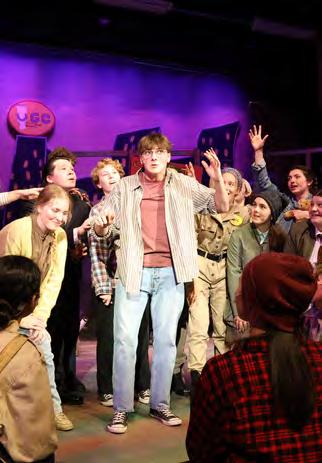
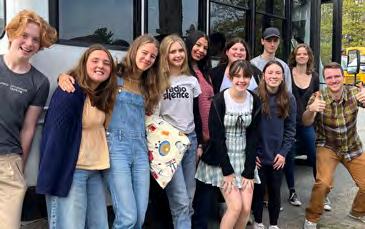
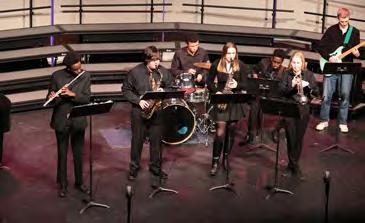
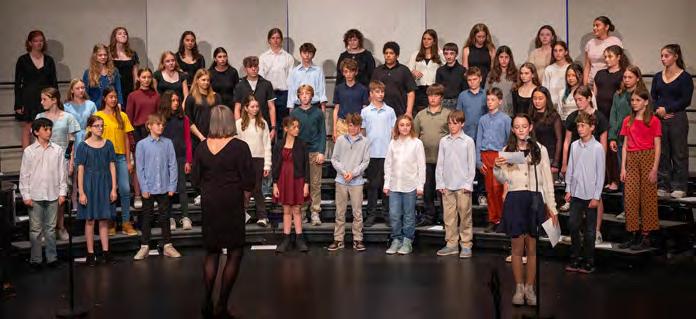
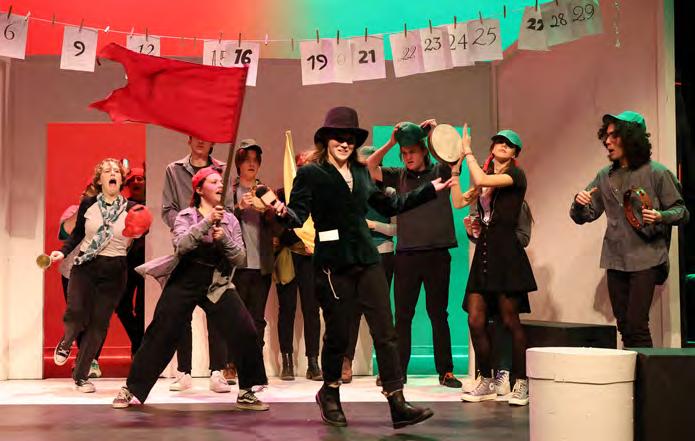
Upper School Jazz Combo participated in two festivals this year that included workshops with adjudicators and inspiring performances by professional ensembles. The Combo attended the Clark Terry Jazz Festival at the University of New Hampshire and the Maine Band Directors Association (MEBDA) Jazz Festival at Westbrook High School.
Upper School actors and stage crew members created an incredible night of theater titled “Too Much Light Makes the Baby Go Blind” (30 neo-futurist plays in 60 minutes) in early March. They took the show on the road to the Maine Regional Drama Festival at Thornton Academy, where they took home second place for Class B schools.
11 Upper School musicians were selected as All-State Musicians to represent Waynflete at the All-State Jazz Festival, All-State Orchestra, and All-State Choruses. In addition, two Upper School singers were selected for the District II Honors Chorus and 13 Middle School students performed in the District II Middle School Honors Chorus, Orchestra, and Band.
In mid-May, the Middle and Upper School Danceflete Collective paid tribute to Susan Charles Nelson, who retired this year after a 49-year run as Waynflete’s beloved dance teacher, in a suite of dances choreographed by Nora Petroliunas and the dancers. The close of the suite (to The Ronettes’ “Keep on Dancing”) brought Nelson on the stage through a tunnel of dancers to take a final, triumphant bow. The standing-room-only audience gathered in the Franklin Theater for the Enrichment and Danceflete Collective Spring Concert rose to their feet and erupted in cheers of love, admiration, and gratitude.
Fifth graders (soon to be sixth graders!) got the inside scoop on Middle School from a panel of teachers. Wait—how does this schedule thing work?!
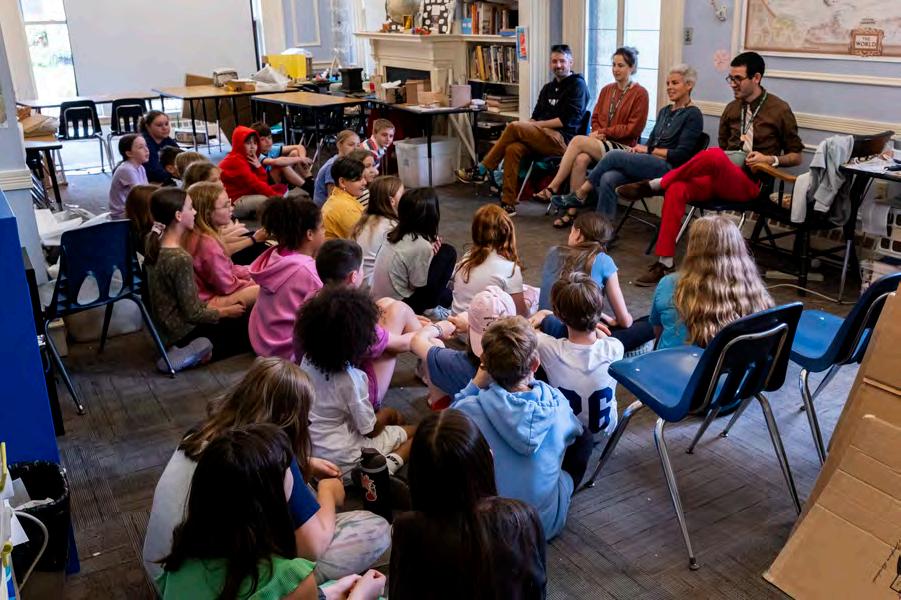
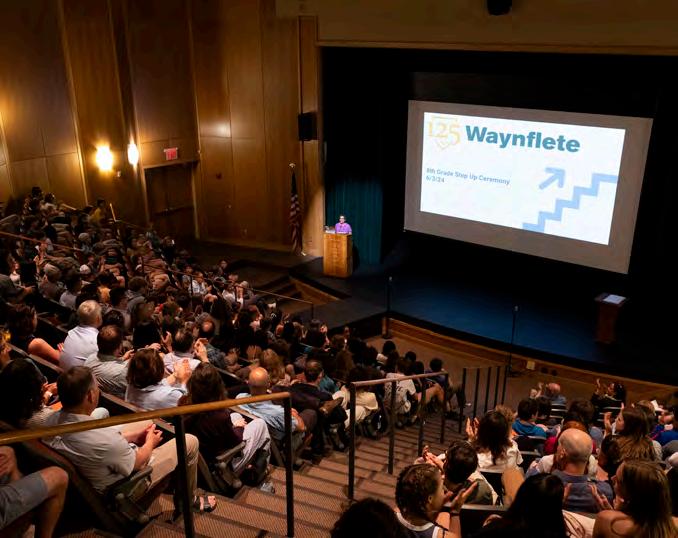
The entire eighth grade joined their families for the first-ever Step-Up Ceremony, an event designed to acknowledge all the important work students have accomplished during their time in Middle School and create some excitement as they “step up” to Upper School. Students received a T-shirt and poster with quotes from their peers as faculty members read their reflection to the audience. The celebration culminated in a reception where students and their families reminisced about the Middle School years.
More than 1,000 people—including many alums and past parents—gathered at Thompson’s Point on June 7 to celebrate the 74 members of the Class of 2024. Wayne the Wombat made his first Commencement appearance, the Upper School Chorus performed “Everyone Shine” (a school song specially commissioned for our 125th anniversary), and staff member and alumna Cristin Walsh ’98 baked a delectable rendition of the time-honored graduation cake.
Snell Family Farm in Buxton provided a note of narrative closure to the Class of 2024’s school experience: first as a favorite field trip destination in their Lower School years, then as the provider of flowers for Commencement.
2024 College Matriculation
Bard College
Bates College
Boston College
Boston University
Bowdoin College
California Polytechnic State University, San Luis Obispo
Colby College
Colorado College
Concordia University
Connecticut College
Cornell University
Culinary Institute of America
Davidson College
Duke University
Elon University
Emerson College
Furman University
Hamilton College
Iona University
Ithaca College
Lafayette College
Macalester College
Massachusetts Institute of Technology
MCPHS University
Middlebury College
Northeastern University
Providence College
Roger Williams University
Royal Northern College of Music
Sarah Lawrence College
Scripps College
Smith College
Southern Maine Community College
Stonehill College
Suffolk University
Syracuse University
Trinity College
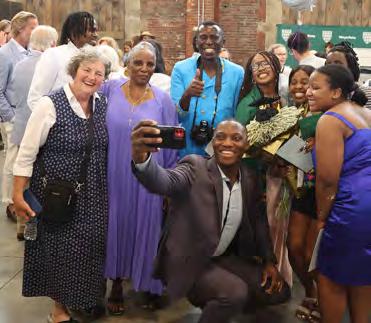
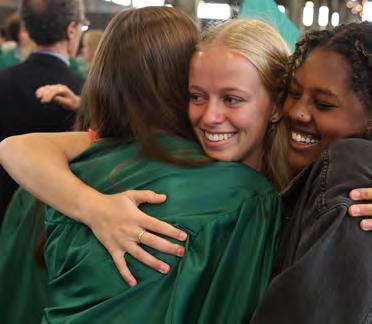
Trinity College Dublin
Tufts University
University of Colorado Boulder
University of Maine
University of Miami
University of Southern Maine
University of St. Andrews
University of Toronto
University of Vermont
Vanderbilt University
Vassar College
Virginia Polytechnic Institute and State University
Wake Forest University
Wellesley College
William & Mary
Yale University




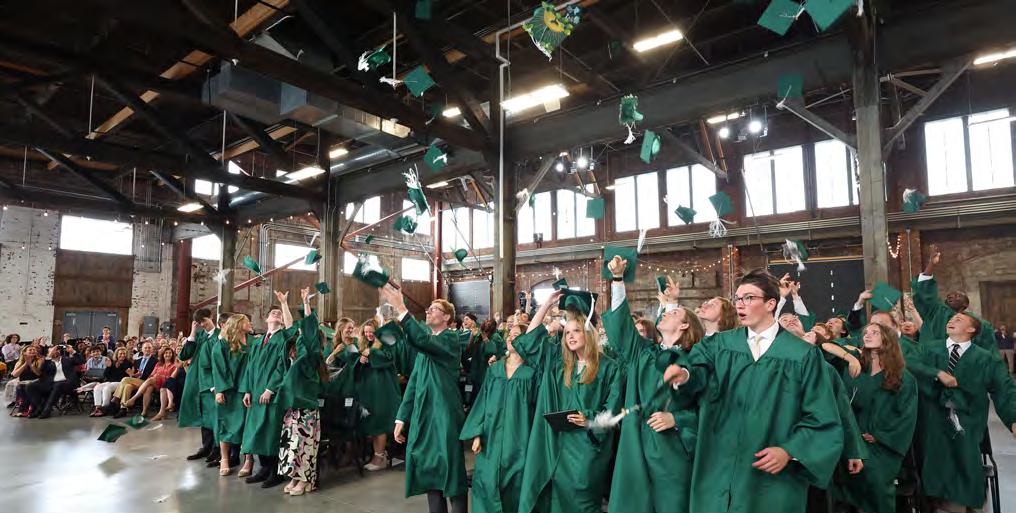
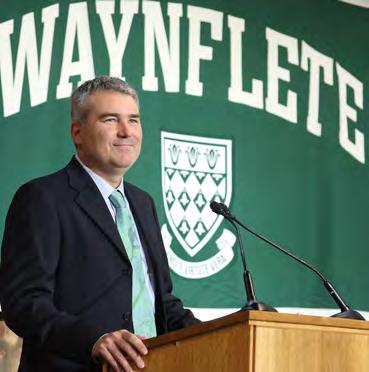

Curious and courageous learners, Flyers delight in discovery, draw on diverse perspectives and accurate sources, and employ flexible, critical thinking to deepen their understanding.
Agile and resilient problem-solvers, Flyers embrace risk, stretch skills, propose solutions, and take direction from feedback and motivation from failure to achieve their most ambitious goals.
Innovative and imaginative creators, Flyers pursue personal interests, develop unique talents, express authentic ideas and emotions, and prioritize health and humanity as they share stories and shape their world.
With a strong sense of self and care for others, Flyers eagerly engage in honest dialogue, forge allyships and friendships, and combine forces with other changemakers to advance the common good.

Waynflete’s Portrait of a Graduate is the result of a collaborative process that included input from our entire faculty. It is designed to inform what we teach and how we teach it. The portrait enables teachers to align program, pedagogy, and assessment around a shared vision of student success.
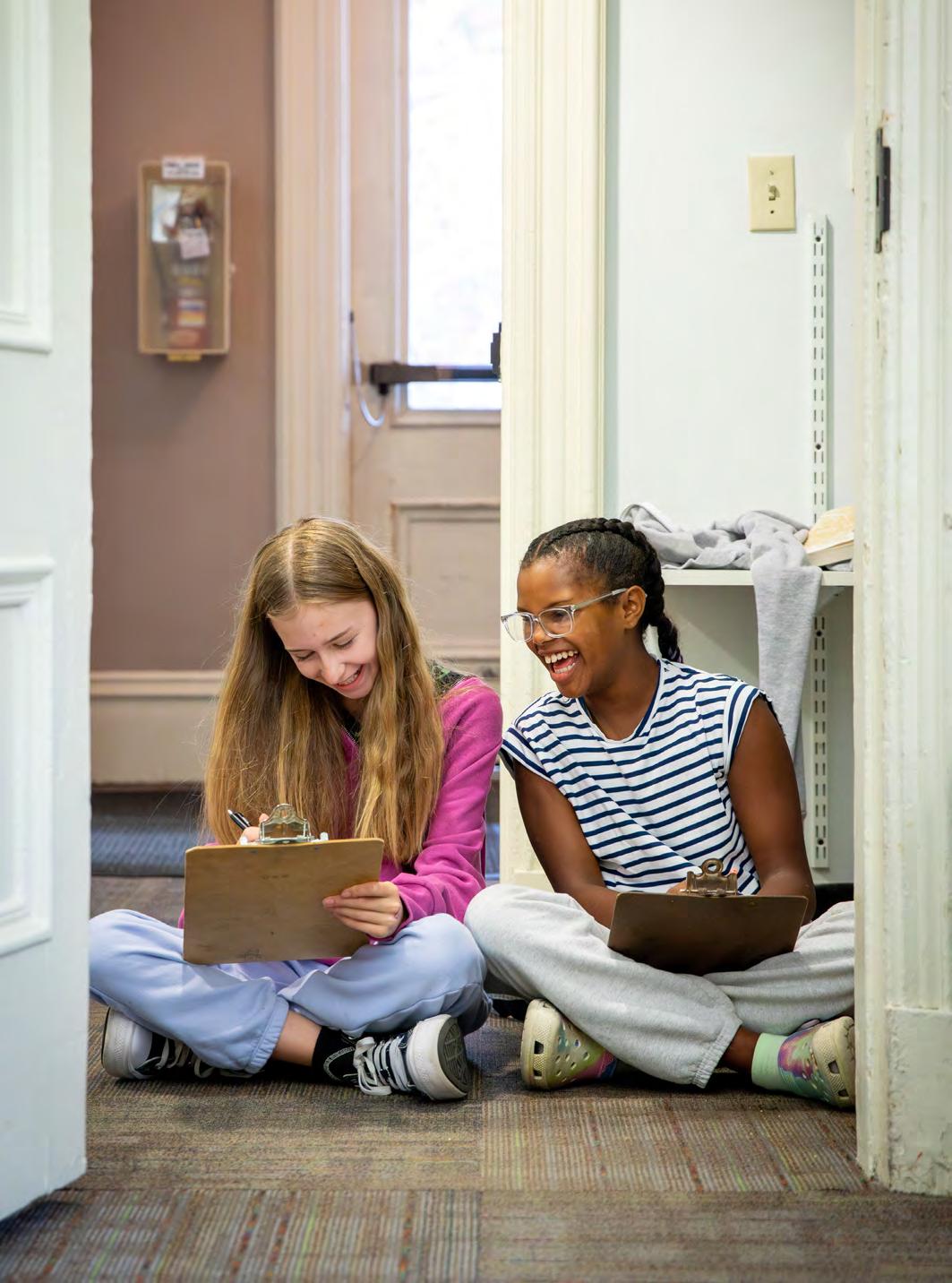

The Senior Clap-In—the Upper School’s newest tradition—returned for an encore performance in May. Students, faculty, and staff from all divisions celebrated the Class of 2024 with signs, music, pom poms, and bubbles on the seniors’ last day of classes prior to heading off to work on Senior Projects. Check out a first-person view of the experience at bit.ly/24mag-2.
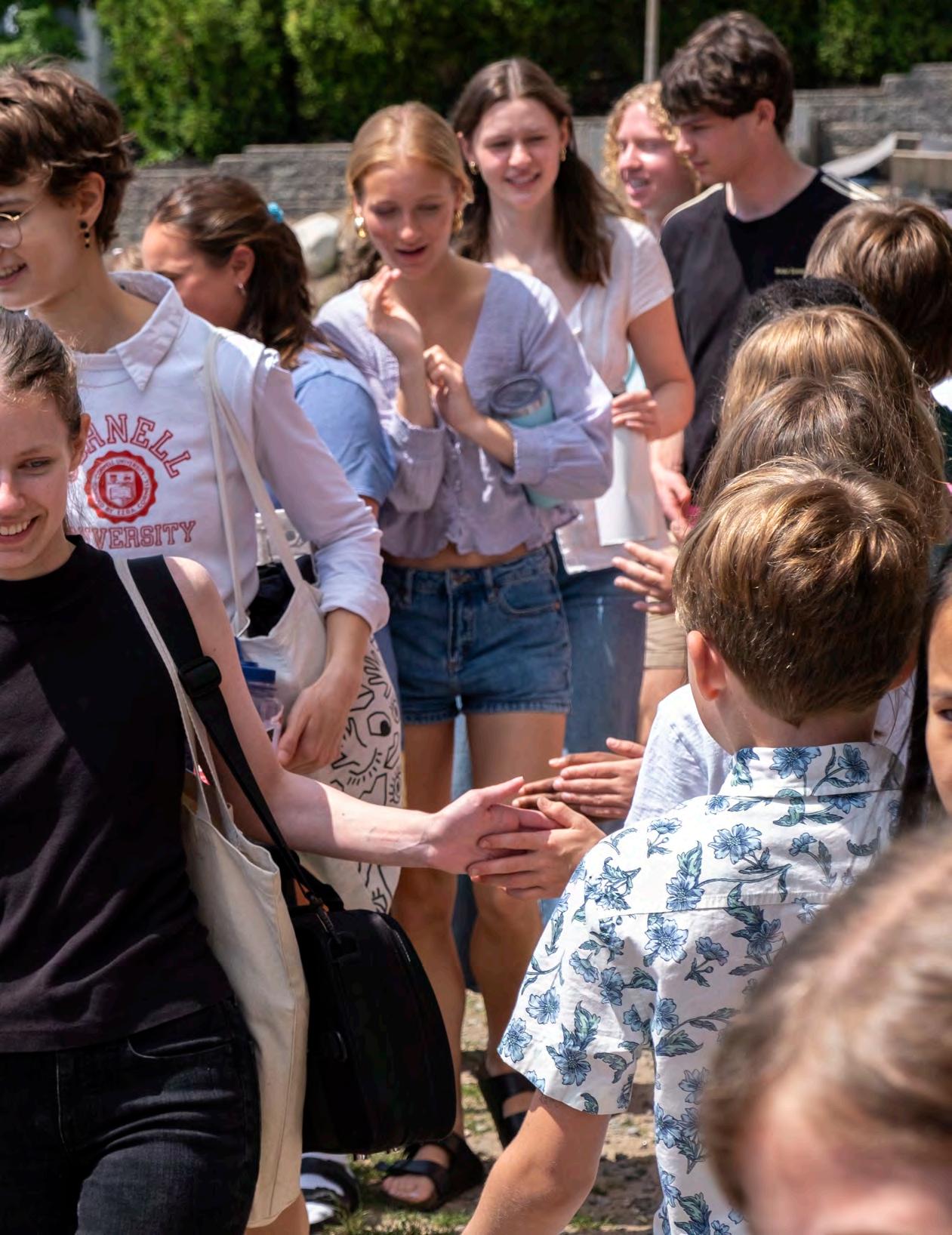
Please email questions, comments, or suggestions to magazine@waynflete.org
Parents of Alumni:
If this magazine is addressed to a family member who no longer maintains a permanent address at your home, please email us (alumni@waynflete.org) with their new mailing address. Thank you.